 | |
|  |
|
|
view titles only (low bandwidth) |
| |
| A* episode 7 movie in German | Jun 30, 2011 7:14 AM PDT | url |
| | |
Added 1 new A* page:Vitruv and Starschwar have translated A* episode 7--the animated version--into German! Here it is:
video on Youtube
For future reference, the link to it can always be found on the main episode 7 movie page--and episode movies can be gotten to from the "episodes" link in the site's top menu.
So yep, if you hadn't found them before, I did indeed animate A* episodes 1-7; in fact, A* was originally animation *only*, until I started spending more time on the animations and they were taking longer and longer and I didn't want people to have to wait so long, so I started posting my daily animation work as still pages as I went along--that was back at the beginning of episode 5. I don't animate new episode anymore, because it takes so long and anyway tons more people seem to want to read them as daily comics than want to watch them in a video with my silly voice acting and limited animation techniques...BUT if you enjoyed episodes 1-7 in comic form and *haven't* watched the animated versions yet, you'll probably have fun with them, if only to hear what I tried to make the characters sound like. =p
From this translated version I even learned some mild German cursing. :D Thanks yet again, Vitruv and Starschwar!
~~~~~
Yesterday I said I thought I'd get to another self-indulgent rambling discussion of something to do with how I make A*, but man it is late/early--spent way too much time twiddling with the comic page layouts today, but at least I think I figured out how to make the page not pop around if it has to insert a vertical scroll bar in some browsers (Firefox and Chrome were the ones I tested), and I finally had to learn some CSS to get those animating boxes under the comic to stay put, mostly, since they had little regard for my olde schoole HTML tables. But I think I managed to sort that stuff out, for the most part; anyway, it's better than it was yesterday. :P
So maybe I'll get that discussion in tomorrow, or hm well sometime soonish; it has to do with a comment a well-read reader on Twitter (Yes A* has Twitter! We are highly advanced now!) made about the neuroscience stuff I was going on about last week, and from what he said I think it's clear that at least one real science fiction writer thought it through much better than I did, and years ago! So I will make some excuses about why I didn't come up with what he came up with, more or less. I think.
|
·····
|
| |
| Dumb ways to draw stuff | Jun 29, 2011 3:58 AM PDT | url |
| | |
Added 1 new A* page:"Beautifully eery and haunting imagery set against a sci-fi background in black and white. What's not to like?"
--Brandon Oliver, www.twxxd.com |
Yesterday I was talking about my troublesome tendency to draw heads cartoonishly, unconsciously; well, I didn't do that today, but I had sort of the opposite problem--drawing the head way too deliberately and boringly. And the perspective was just slightly off for the top of it, too, I think. So anyway I made myself erase it and draw it again, this time trying to keep the stylus livelier. Here's how it went, starting with the original storyboard scrawl:

(^ Two of those panels are identical because I sort of screwed up making the chart (two of the history layers I used differed only in places other than the head). Can you find them??)
Worth the redo, I think.
One of the oddities of drawing with the Lasso Tool in this ancient version of Photoshop that I use (version 4, from the fabulous year 1996) is that a) the zoom level at which you draw affects the final line quality, unless b) you're moving the stylus very quickly. Weird, hm? Since a tremendously generous friend gave me their unused 1080p monitor midway through episode 12, I've been able to draw A* pages zoomed in at twice the final size you see on the site (and the actual working file's pixel dimensions are eight times the final size), which lets me get smoother lines and more refined detail.
Those are nice things to have, BUT drawing at double size also makes it hard to do quick reflex drawing on a large scale across the image--the type of drawing that will result in nice smooth lines with this ancient Lasso Tool. Also, you just have to move your hand more when drawing at larger sizes. :P So lately I've mostly been starting a drawing with the page zoomed out to the size it appears on the site (12.5% zoom in Photoshop); I do the layout work at that zoom level, moving briskly. Then when I'm satisfied with the rough layout, I'll zoom in and work on the details and tidying up.
One interesting side effect this has is that the stuff drawn at 12.5% zoom has a slightly different texture than the stuff drawn at double size (25% zoom). For instance, the black lines of Selenis' hair in yesterday's page were drawn at 12.5%, and their edges have a rougher quality than, say, the edges of Selenis' suit in today's page, which I drew zoomed in at 25%. And that was partly intentional: I wanted the hair to look rough, and the suit to look smooth. It's a very subtle difference and you're all probably saying "he spends way too much time squinting at little squiggles," but nyah, this stuff fascinates me. :P
So the mistake I made today was really one of forgetting to start the drawing zoomed out and moving briskly; instead, I just started it at double size (25% zoom), and was making these nice smooth lines and all and intricate elegant shapes, but there was a stasis to the process that resulted in a pretty dead head on her shoulders. So when I redrew her head, I did it mostly at the zoomed-out size, 12.5%, and was able to get a lot more zest into the thing.
~~~~~~~
Another curio of Photoshop 4: it doesn't do any aliasing when you're zoomed out on an image, so when working zoomed out, as I almost always am, everything looks all speckly and jagged, and you can't really see what the image will look like when shrunk down until you actually do shrink it--so I have a duplicate+shrink macro with which to generate previews. Sheesh! And since that probably didn't make any sense at all, here's an example of PS4's zoomed-out, unaliased view--it's yesterday's line work, seen at the top at 12.5% zoom in PS4, and at the bottom in the bilinearly smoothed preview generated with my macro:

See? The top is what it looks like when I'm drawing it zoomed out at that visible size in Photoshop 4--all speckly and aliased. It is indeed inconvenient to have to flip the macro (result seen at the bottom, having scaled the image down to 100%, with edges nicely smoothed) to get a decent idea of what the actual final lines will look like; however, on the plus side, since Photoshop 4 doesn't waste any time doing scale-smoothing effects on the fly as you draw at various zoom levels, the drawing is much more responsive! I'm sort of surprised that turning off their automatic preview zoom smoothing (yeah that's a bad name, I know :P) isn't an option in later Photoshops, but I don't see it in Photoshop CS2, at least. And I can't stand trying to draw with the Lasso Tool in CS2, 'cause it's so much less responsive than it is in jaggy ol' 4 (the Lasso in CS2 also does its own robotic auto-smoothing, so drawing slow or zoomed-out *doesn't* result in rougher edges...but that again slows the drawing down a bit, and besides, I don't like the way auto-smoothed lines come out kinda generic-looking--like most anything most webcomic artists draw in Manga Studio, for instance, which does a TON of auto-smoothing: so much so that you can actually see it move your lines around after you lift up the tip of the stylus :p; you can turn that off, but hardly anyone does--for fear of having to face the rough lines of their own art, I suppose).
(I don't actually shrink the image to the final size in Photoshop for the release version, though; I export it as a GIF at full (8x) original size, then run an IrfanView batch process on it to shrink it without haloing artifacts, save it as a highly yet losslessly compressed png, and delete the GIF all in one go:
"C:\Program Files\IrfanView\i_view32.exe" %1 /resize=(0,475) /aspectratio /resample /gray /convert="%~dpn1.png"
if /I %~x1==.gif del %1
Fun!)
I know you didn't read all this! :D I think I will have one more really self-indulgent, breezily self-examining post about my A* work tomorrow, and then maybe we'll get back to some good ol' regurgitation of neat space stuff from real smart web sites.
|
·····
|
| |
| Of balloons and bowlers | Jun 28, 2011 5:30 AM PDT | url |
| | |
Added 1 new A* page:"I'm not an avid sci-fi fan by any stretch of the imagination... but I must say I am very fond of A*"
-- Wild Horse, www.wildhorsecomic.com |
I'm going to let you in on a shameful secret of mine: I have a tendency--which I now know I must remain ever on the alert against lest it get the better of me--to draw rather cartoonish heads.
Yes, it's true! I also seem to have an odd tendency to give these cartoonish-headed people rather cartoonish personalities, broadly painted for comic relief like some Shakespearean clown (although that comparison is a vast disservice to Shakespearean clowns, the lovable devils).
And I had sworn--sworn!--to myself that once I finished what I wanted to do with Proctor and Mar, who had been forced to play the clowns through many of the first episodes of A*, I would stop making silly characters, buckle down, and make only intricately etched, non-clownish-looking characters from here on out. So after their last bit at the end of episode 11, it was full steam ahead with hardcore, realistic characters--right?
So imagine my dismay at my own lack of gritty self-control when we start getting into episode 13 here and I find that some of the episode's supporting characters have perhaps some, shall we say, three-ring qualities. Not to name names, but

And although I can't stop myself from being somewhat pleased by the way I managed to render those two in those two particular drawings, at least compared to some of my other attempts at them, I also can't help but notice that certain features are leaning toward an exaggerated type of physiognomy that I had meant to leave back in episode 11
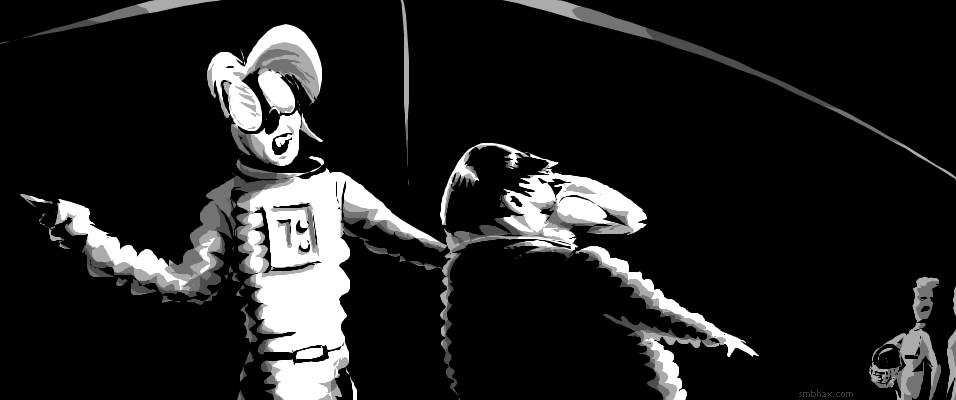
Furthermore, there's a certain consistent temperamental and physical combination in these repeating goofball pairings that I can't seem to shake, bearing a striking resemblance--now that I've thought of it--to charming characters from many delightful black and white movies

(source)
to which I was subjected--quite willingly, I should add--as an eager and impressionable youth.
Alas! All I can say is that I'm trying to be more aware of and combative against these recalcitrant cartoon tendencies of mine; for instance, just a few pages ago I roughed out a drawing of one of these troubled characters, thoughtlessly crowning him with the big balloon head that my clumsy hands just can't seem to get enough of, and I was polishing it and shading and sailing right along, and even uploaded it, and it was only after I had gone and had a bite to eat and come back to glance at the site that I noticed the full horror of what I had done (yet again); it was really late at night by that time but I couldn't live with it up there a moment longer, and redrew the head in a desperate attempt at correction with what little awareness remained in my faltering faculties:

Thankfully, that second try seemed to do the trick--at least, it got rid of the balloon head. And this is what I must always strive to do! I will defeat these clownish inner demons yet...or at least, tame them somewhat--use their power...FOR GOOD!
Actually, I don't know what that means. Just stop it with the balloon heads, self. :P And remember that 2-bit hard black and white is probably quicker to do than your preciously shaded round cartoon characters, anyway. Either that, or just give up and start putting bowlers on their heads ("devised in 1849 by the London hatmakers Thomas and William Bowler"!).
|
·····
|
| |
| Old news is...well heck it is/was Friday :P | Jun 25, 2011 6:44 AM PDT | url |
| | |
Added 1 new A* page:i loved how you are able to show emotion and even hints at facial expressions even when characters had masks on. The graphics and the style is befitting of the story, almost like a space Noire. I really dig it, keep up the good work, i'll be chiming in for updates.
-- www.Comicordy.com |
I forgot to plug myself last week, but this week I'm so on the ball! I do a weekend comic called "The Princess and the Giant" that updates Sundays, which you might like to check out some time! Here's a handy teaser link thing to last Sunday's strip:

~~~~
I happened to have to reboot a few days ago...can't even remember why, now...and got a look at my desktop, which I pretty much never see, and imagine what I should find there but an old A* news update I never posted! I pretty much never write them up and *don't* post them, but I think I felt like what I had was too much to stick into one news post, or something (I have tended not to worry about gargantuan news posts lately, you may have noticed. :P). So here is the previously unpublished sequel to this news post from back in mid-February (so I haven't rebooted in a long time, nyah :P):
~~
Now, I said "almost all" of the exoplanets found so far have been the big hot gassy types; well, just last month [Update: that would be January, now :p], scientists confirmed to their satisfaction that Kepler had found the first known rocky exoplanet--which means a smaller planet made of hard stuff like Earth, rather than a gas giant. Planet Kepler-10b, about 560 light years from Earth, is only a little larger than Earth, but four times as massive (the Wikipedia article describes it as having "the density of an iron dumbbell"). Like the other planets found by Kepler, it's very close to its star, so close that the sunny side gets hot enough to melt iron, and orbiting so rapidly that a Kepler-10b year is shorter than an Earth day. And rolling in more NASA artwork, here's their idea of what it might look like:
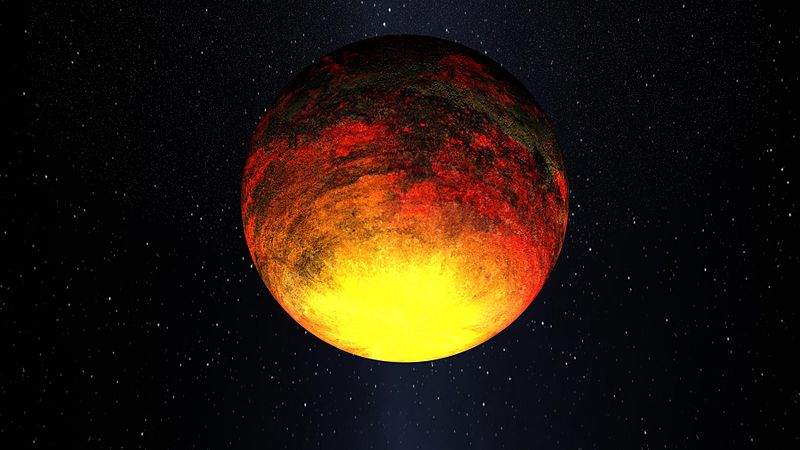
image by NASA (source)
It's also interesting how they confirmed its existence: Kepler's eight months of light observations of the star showed that it dimmed by "one part in ten thousand" every 0.83 days, which seemed to indicate a small, close planet--which would be big news. So then the Keck Observatory studied the star with its HIRES instrument ("High Resolution Echelle Spectrometer") to get a very detailed spectral reading of the star's light: detailed enough to detect a steady shifting in the relative red and blue color of a star's light, which would occur if the star was being tugged toward and away from the observer by an orbiting planet, like so:
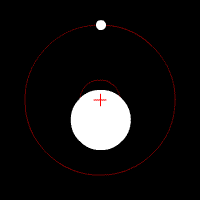
image by Zhatt (source)
(Although in the case of Kepler-10, that Sun-like star would be relatively much larger than the planet, and wobble much less.)
That type of study of light is called Doppler spectroscopy, and indeed they were able to confirm a shifting in the light which, in light Kepler's findings, could only be due to the star being tugged by a tiny, heavy, nearby planet, and so Kepler-10b went into the record books!
|
·····
|
| |
| Would you like some chips with your brains? | Jun 24, 2011 3:26 AM PDT | url |
| | |
Added 1 new A* page:"A* has set the standard for greatness in webcomics. As a reader, I am very impressed. As a webcomic producer, I am insanely jealous."
-- TonyDoug Wright, Champion City Comics |
Before I launch into the third and final part of this week's foray into the neuroscience (or what little gloss I can glean of it) of Selenis' neural implants and doohickeys, I wanted to point you to an interesting article I just came across today, which talks about a new brain interface being developed of the ECoG type, which is short for "electrocorticography," "in which a grid of electrodes is surgically placed directly on the surface of the brain to monitor electrical activity. This technology is currently used for surgical planning in patients with uncontrolled epilepsy in order to find the origin of their seizures." But now they're talking about refined versions that can do much more, like control artificial limbs, and I thought the part describing how patients learn to use it was pretty interesting:
"Tests of more than 20 patients have shown that people can quickly learn to move a cursor on a computer screen using their brain activity. Researchers first ask patients to imagine performing a certain action, such as moving a computer cursor to the left. They then identify changes in the frequency of electrical signals that correlate with that movement and use those to control the computer. The patient learns to more precisely control his or her brain activity and hence more reliably performs the task within half an hour."
So the connection between brain activity and result doesn't necessarily have to be hard-wired--you just give the interface to the subject and let them teach it to themselves on the go!
~~~~~~
Okay anyway onto the third neuroscience part proper, which has to do with memory: Selenis' many lives in cloned bodies are made possible in large part by the transfer of memories--or at least sensory data, but ideally both...--from her past clones into the newest clone. Is that possible? Can memories be transformed into digital signals, stored and transferred, and then at some point be put back into a brain in a form the brain can use?
As far as I could tell when I tried to comb Wikipedia about this, human memory is one of the things that neuroscience doesn't know very much about--its exact mechanical operation, anyway. The most I was able to come up with--and now I'm not sure where this was, but maybe it's somewhere I'm currently overlooking in the page I'm going to link shortly--was a suggestion that memory actually consists of synaptic connections and receptors, or something like that, that have become streamlined...or something...man this was vague and my own memory is pretty bad :P...through repeated use under a certain configuration.
That doesn't sound like much, but when you consider that there are maybe about one billion neurons in the human brain, with maybe something like one hundred trillion synapses connecting them (and that's down from ten times that, one quadrillion synapses, in a three-year-old child--the number of synapses decays from that point, stabilizing in adulthood), maybe it starts to add up to something.
And maybe that huge tangle of neurons and synapses would be pretty darn tough to read and write to artificially; it certainly isn't something that can be done on anything like a large scale with our current technology. But--
Ah hold on, I found that memory mechanism I was stumbling over. It's called long-term potentiation, and it's basically a phenomenon, first artificially induced (accidentally) and observed in 1966, of "a long-lasting enhancement in signal transmission between two neurons that results from stimulating them synchronously. It is one of several phenomena underlying synaptic plasticity, the ability of chemical synapses to change their strength. As memories are thought to be encoded by modification of synaptic strength, LTP is widely considered one of the major cellular mechanisms that underlies learning and memory."
It still isn't know exactly how that all works on a molecular level, but it does work. So in theory, if you got really good and efficient at stimulating individual neurons, and could also *read* the signal transmission levels between neurons on a wide scale--or at least knew where to put patterns you wanted to lay down, anyway--*maybe* there's some sort of mechanism for transferring memory there.
On the other hand, a simpler solution might be simply to play back the sensory data that needed to be remembered--like a long burst of a super-sped-up-multi-sensory movie--directly into the appropriate areas of the brain, and let the brain do the re-wiring itself.
Partly because LTP was first observed there, it is thought that long-term potentiation and memory have a lot to do with the squiggly little bit of the brain known as the hippocampus:
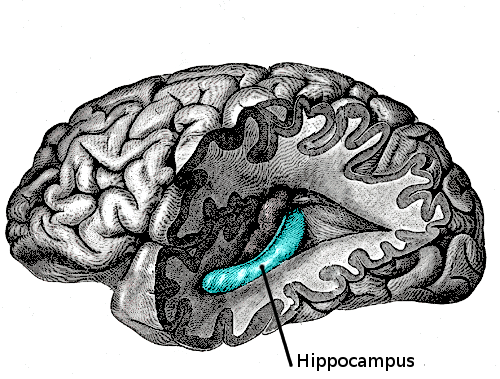
image from Gray's Anatomy of the Human Body, 20th edition (source)
The hippocampus is one of the first places to suffer damage from Alzheimer's, for instance. So a lot of memory research involves poking around in hippocampi, and the claimed results of a USC study on rat hippocampi published just last week sound like quite a breakthrough.
The hippocampus has been connected with the conversion of short-term to long-term memory, so the researchers, having trained rats to press two levers in an alternating pattern, and having observed changes in the rats' brain activity between the two major internal divisions of the hippocampus, then gave the rats a drug that specifically inhibits activity between those two parts of the hippocampus, and observed the result: the rats could only remember which lever they had thrown first for 5-10 seconds.
But that's far from the most interesting part of this study. See, having studied the intra-hippocampic brain activity of the rats while they were learning, the researchers were able to gain an understanding of the hippocampus' short-to-long-term memory encoding process sufficiently to be able to program it into an electronic device which, when implanted into other rats, actually improved their long-term learning capability: they could remember the lever-pressing sequence with longer and longer delays between lever presses. And not only that, but when they triggered the artificial hippocampus sequence on memory-inhibited rats, the drugged rats were then able to "remember" the correct pattern.
So they've been able to put the algorithm our brains (or rat brains, at least) use for converting data into long-term memory onto a computer chip, which you can see here. That's not only mind-blowing, it's mind-restoring!
So maybe this stored-memory system Selenis uses to bring her new clones up to speed isn't quite as far-fetched as I had secretly feared. Whew!
~~~~~
There's a specific biological aspect of her whole longer-living-through-clones procedure whose feasibility I sometimes, in my darker moments, begin to doubt, and which I hinted at on A*'s Facebook page earlier today. So I need to study up on that one, and hopefully it will turn out as well as the neuroscience part has! Or at least, it'll still be a scientific gray area. >_>
And yes, that was a brainy pun. =PP
|
·····
|
| |
| Who needs muscles when you got a brain | Jun 23, 2011 3:38 AM PDT | url |
| | |
Added 1 new A* page:"A* is a visual tour de force with haunting, black and white artwork and an engaging storyline, my only complaint is that there isn't more to read."
-- Connor Shearwood, Pathways Chronicles |
Yesterday I talked about how Mother's digitized voice speaking directly into Selenis' head could work, and related it to the current real technology of cochlear implants, which create the sensation of hearing with electrical impulses applied directly to appropriate parts of the nervous system.
What about some of the other things Selenis' neural implants seem to do, though? As I mentioned yesterday, some of the things she has done in the comic suggest she has implants enhancing her vision--giving her eyes in the back of her head, as it were--and perhaps additional sensors capable of monitoring, for instance, specific vital signs of nearby individuals. One could imagine that these implants might give her feedback by creating "visual" displays directly in her brain, perhaps; I've tried to avoid drawing pages from her point of view with some sort of implant-generated visual overlays because that's been overdone in film and so forth to the point of being tacky--in any case it might be nicer to imagine a rather more elegant solution where the implant data is converted directly into thought, so she just "knows" something without having to re-interpret it from simulated visual data.
But like we did yesterday, let's start with the simple case: is it feasible that artificial signals could create the sensation of vision?
According to Wikipedia's "brain-computer interface" page, the answer is "yes"; in fact experiments with that sort of thing go back to the 70's. In 1978, for instance, a prototype implant connected to a blinded man's visual cortex succeeded in producing the sensation of seeing light; the subject could only see shades of gray, and had to be connected to a two-ton mainframe, but that has now been reduced to a portable device, and since at least 2002, the resolution of the simulated vision has improved to the point where an otherwise blind user is able to drive a car around a parking lot.
In 1999, researchers at the University of California, Berkeley were able to reverse the process: working with cats, by reading electrical signals from "177 brain cells in the thalamus lateral geniculate nucleus area, which decodes signals from the retina," they were able to decode the firings of the neurons recorded while the cats watched some short films, and reconstruct (albiet in low resolution) scenes and moving objects from the films, using only the data recorded from the brains of the cats.
In 2008, Japanese researchers were able to achieve a similar result with human subjects, and without using implants: using functional magnetic resonance imaging ("fMRI") to map blood flow changes in the cerebral visual cortex as the subjects viewed a series of images, they were able to reconstruct the images using only the recorded fMRI data from the subjects; "while the early results are limited to black and white images of 10x10 squares (pixels), according to the researchers further development of the technology may make it possible to achieve color images, and even view or record dreams."
Now that is significant for Selenis' implants, because as has been mentioned on a few occasions, her cloning system requires sensory transmissions from active clones to be sent back to Mother, where they are deciphered and stored, to be implanted into the next clone as memories. So having them on-hand in digital form, anyway, doesn't seem too unfeasible in light of recent advances in the field.
Not only that, but many experiments, again going back to the 70's, have shown that animal and human brains can learn to control artificial mechanisms through brain signals; I think the one I had in mind when I was coming up with this stuff for Selenis was a (apparently 2008; I thought I remembered one much earlier, maybe not) study where monkeys were able to operate a robotic arm using only their brain. A note on the Wikipedia page says that a Johns Hopkins researcher in the 80's found a "mathematical relationship between the electrical responses of single motor-cortex neurons in rhesus macaque monkeys and the direction that monkeys moved their arms (based on a cosine function)." So there you have it: you need geometry (all right so it was probably more like calculus in this case) for neuroscience, too. Dang.
But isn't it just fascinating that mathematics can be used to encode and decode brain signals? And that we (or really smart people with lots of study and training, anyway) can figure out the math behind the brain's thought codes? We've long taken it for granted that you need math in rocket science and computer programs and so forth, but now real, usable results are coming from applying mathematical functions to brain activity.
There have also been experiments using electroencephalography (reading brain activity without implants, although maybe currently you need a fun apparatus like this:
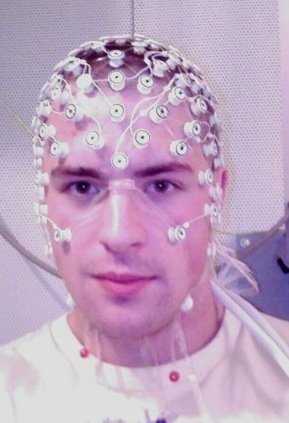
image by Thuglas (source)
) to control things, like moving cursors on a video screen; implants like the BrainGate
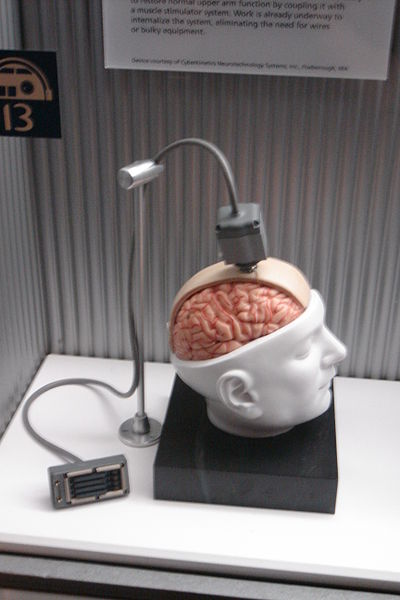
image by PaulWicks (source)
allow for even finer control, where a human brain can move a robotic arm. (But does it come in USB yet? That plug in the photo is a little clunky. :P)
So again, it seems like even things such as Selenis "thinking" words back to Mother--communicating with her computer program simply by forming words in her mind--or controlling functions of her onboard implants--telling an imbedded sensor array to scan Solvan Mar's vital signs, for instance--can't be considered outside the realm of possibility. Neat.
There's one more neuroscientific function of Selenis' technology whose feasibility I want to discuss, and we'll do that tomorrow, although I mentioned it in passing above--can you guess what it is? And I'm particularly excited about it because it just so happened that a day or two ago, a friend of mine on Facebook linked to an article showing what appears to be a significant breakthrough in the field, one whose implications I could only imagine and try to predict when I was coming up with this stuff a year or more ago.
|
·····
|
| |
| Neuroscience: harder than rocket science | Jun 22, 2011 3:52 AM PDT | url |
| | |
Added 1 new A* page:"A* manages to create depth without cluttering its panels, and makes use of what I'd have to call a cinematic composition to great effect. If you are a black-and-white enthusiast, this comic will thrill you. if you're a b/w artist, school is in session."
-- Sam Medina, Jake the Evil Hare and Darkfell |
I made a new little button icon for A*!

Innit cute? You can use it...well, wherever you like, if you want. *I'm* using it for a new advertising campaign, whee!
~~~~~
I call A* "hard" science fiction, and exactly what that means sometimes varies by interpretation, but here I generally mean that it restricts itself to things that could happen without violating scientifically established laws of the known universe. So you won't see faster-than-light travel or handheld death rays here, for instance.
Those are just the easy, obvious ones to avoid, though. Sometimes I get a little nervous about more marginal things--things that maybe don't outright break the laws of science as we know them, but that make you wonder "would that *really* be possible, even given centuries of technological advance?" Or at least, sometimes they make me wonder about it.
Fortunately, sometimes it turns out that I may have guessed right. One thing I was worrying about along hard science lines, you see, were Selenis' neural implants; you could be forgiven for not realizing she has such bionic-woman-sounding things, since I haven't emphasized them unduly; maybe the closest I came was Solvan Mar admiring her "neuro implants" (not sure why I had him say it with quite that spelling now, hm) back in episode 11, after he'd just seen her shoot a man ambushing her from behind, without even looking at him. Later in that same scene, she hints that she may have used them to tell if Mar was lying to her, calling them "my sensors." And it may not have been obvious, but moments later, she used them yet again, to know when the man behind her, whom she had shot earlier, was reviving, and then turning to fire at her.
And of course she uses some sort of implant simply to "talk" to her managing computer program, which she calls "mother," without moving her lips--and, similarly, to hear Mother talking to her.
So I got to wondering... Implanted sensors? Meaningful artificial stimulation of inner sensory receptors? Have I gone too far, or could that stuff actually happen?
Well, once I ask myself that kind of question I just can't sleep until I've solved it, so of course I went trolling around Wikipedia to see what I could turn up. And fortunately, it appears that I didn't go too far from the conceivably possible with these things.
Let's take the relatively simple example of Mother talking into Selenis' head. In a way, I'd like to think that that's a direct radio transmission of (compressed and encrypted, of course) text to a receiver in Selenis' head that unscrambles it, converts it into the equivalent brainwave pattern that comprehends those words, and zaps that directly into Selenis' brain synapses. Which I think is probably within the realm of possibility--but for now let's keep it simple; let's say Mother's speech is translated into sound waves--text to speech, you can do that on Google Translate right now! (or any of umpteen other places on the Internet, but the Google one has a lot of language options, and I get oh so simply amused by the way their English voice translation renders naughty words :P)--and these are sent--we don't want to do this with a tiny speaker in Selenis' inner ear or something, mind you, since that could potentially be overheard by listening devices--by electrical impulse directly into the nerves Selenis uses for hearing. Could that work?
Apparently it could, because over 150,000 people here on Earth already have such a "neural implant"--that's my silly phrase, mind you; these very real implants are called cochlear implants, and they use a tiny microphone to pick up external sounds, which are then run through a speech processor to isolate the parts that are probably audible speech, and translate those into electrical impulse patterns comprehensible to the nervous system; those are then sent into the body, down a wire to electrodes running into the wearer's cochlea, the auditory portion of the inner ear; the pulsating electrical field produced there by the electrodes stimulates the user's auditory--or "cochlear"--nerve, which passes the signal along into the brain, where it is re-interpreted as sound.
Here's a diagram of the internal and external parts of a typical cochlear implant:

image by National Institutes of Health (source)
and here's what the surgically implanted portion of one type looks like on its own:
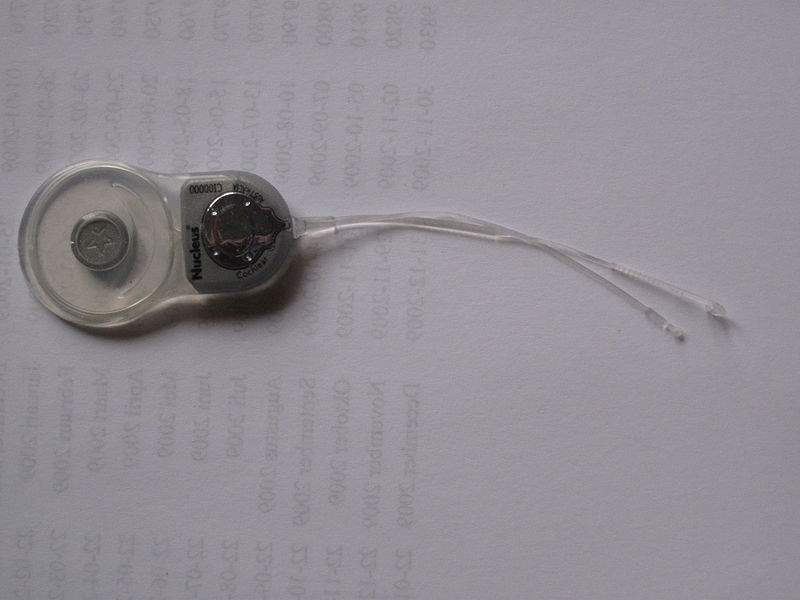
image by Edwtie (source)
And here's a simulation of what speech might "sound" like through a cochlear implant. Spooky!
So I think we're well covered as far as Mother speaking straight into Selenis' head goes. As for Selenis speaking back, and doing other things with those "neural implants," that gets a little more complicated, and I will save that for...maybe next time! It gets into neuroscience, you know (ohh, *that's* probably where I got that "neuro" spelling from...hm I guess that's okay then :P), which has quite a few unsolved problems--a breeding ground and potentially deadly minefield for all sorts of "hard" sci-fi ideas! (I suppose there are probably brands of hard science fiction that only consider stuff that has definitely been proven to work--that doesn't really leave enough room for the fun "fiction" part of it though, if you ask me. :P)
~~~~~~
And I'm just going to sneak something in here that I stumbled across in looking through some of this stuff: the mirror box. It's a simple mirror trick, but it can, apparently, be used to cure or at least reduce phantom limb pain in people who have lost a limb, particularly if it was paralyzed before removal. The theory goes that when it was paralyzed, the victim tried to move it, and received sensory feedback that it didn't move. This sense of being unable to move the paralyzed limb stamps itself into the brain, but then, if phantom nerve sensations after amputation tell the person that the (missing) arm is in a painful position, they're still convinced that they're unable to move it, even in phantom form, and the pain continues as a phantom cramp.
So! The mirror box:
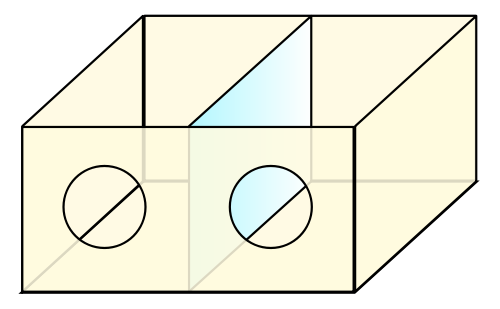
image by Phidauex (source)
The user sticks their good hand into the side with the mirror, and the stump of the other (or maybe just as much as they imagine of it?) into the other side, and then they look at the reflected image of the good hand; mirrored, it now looks like the *other,* missing hand, and in some cases the user is then able mentally to unclench or reposition the phantom limb to a more comfortable phantom position, easing the phantom limb pain.
Neuroscience is pretty crazy stuff sometimes.
~~~~~~
Oh, and I forgot to mention that the pioneering research that eventually led to cochlear devices was a stunt way back in 1790 by Alessandro Volta, the Italian physicist who a decade later would invent the battery: he "placed metal rods in his own ears and connected them to a 50-volt circuit, experiencing a jolt and hearing a noise 'like a thick boiling soup.'" Eek! Well, I hear a buzzing inside my ear when there's no other sound around, but I think that's just because I listened to music too loud or something...and it certainly didn't lead me to the discovery that electrical stimulation of the auditory system can produce the perception of sound, like Volta's trick with the rods did.
Although now I wonder if that did leave him with a buzzing sound. :P
|
·····
|
| |
| Icy ions and hungry supermassive black holes | Jun 21, 2011 1:49 AM PDT | url |
| | |
Added 1 new A* page:"A* is a black and white, panel by panel look into the future. I'll take a room at the Metropole Station."
-- Dugan's Air Force |
An April BBC article (yes I'm kind of behind in my news queue...need to close some of these tabs I've been keeping open! :P) says that auroral activity on Saturn has been linked to the planet's small moon Enceladus, and specifically to the salty ice particles Enceladus' geysers shoot out into space--ions in this material end up forming an electrical circuit with Saturn, connecting at Saturn's poles, where they cause the visual effect of an aurora.
I posted about aurorae on Jupiter and Saturn on the A* forum before (Jupiter's aurorae have been attributed to three of its moons), including this nice old Hubble ultraviolet photo of Saturn's polar lights:
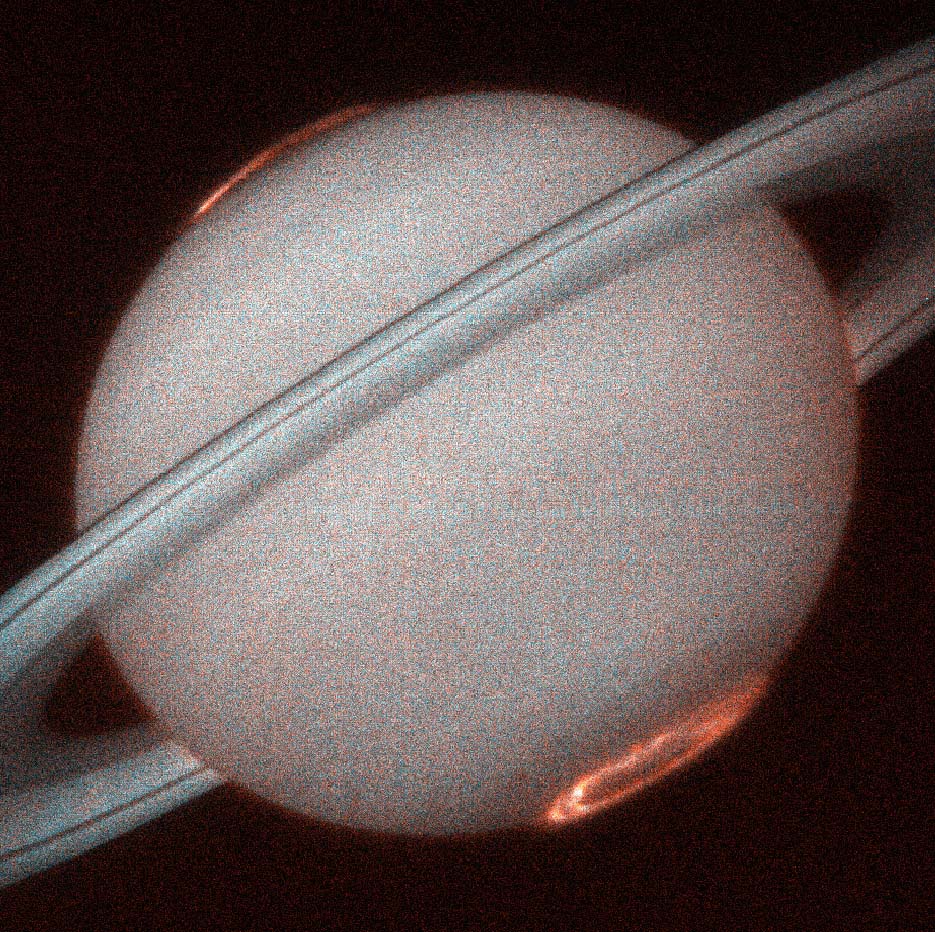
image by NASA (source)
I've also posted on the A* forum about Enceladus before, so handily enough I already have a few photos illustrating its icy activity; for instance, here's the 500 km moon going through the ice crystals it has left in the path of its own orbit
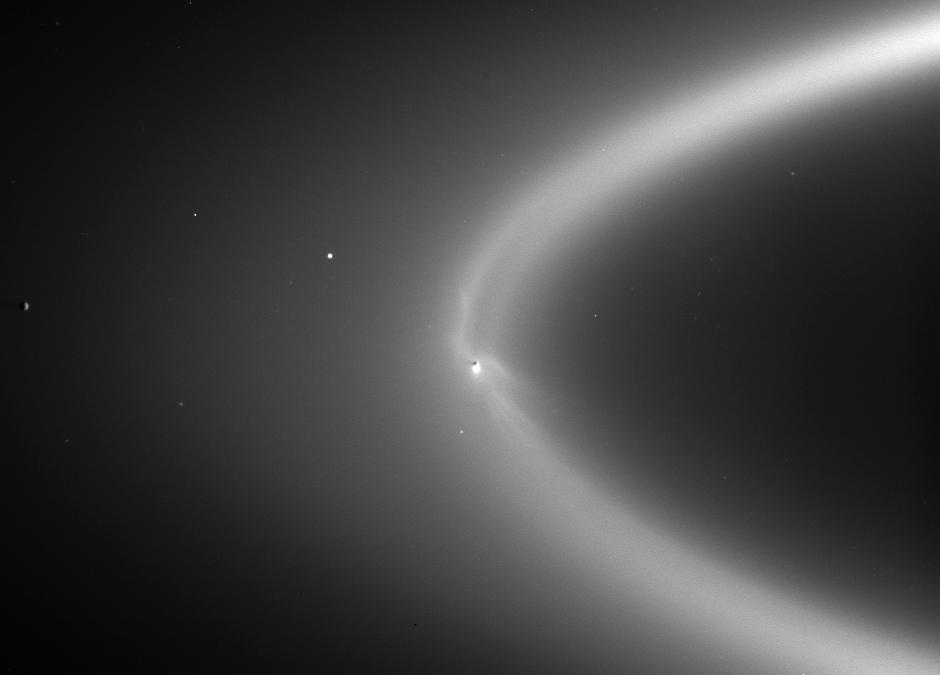
image by NASA (source)
and then we have a nice dramatic wide shot of some of its ice geyser activity:
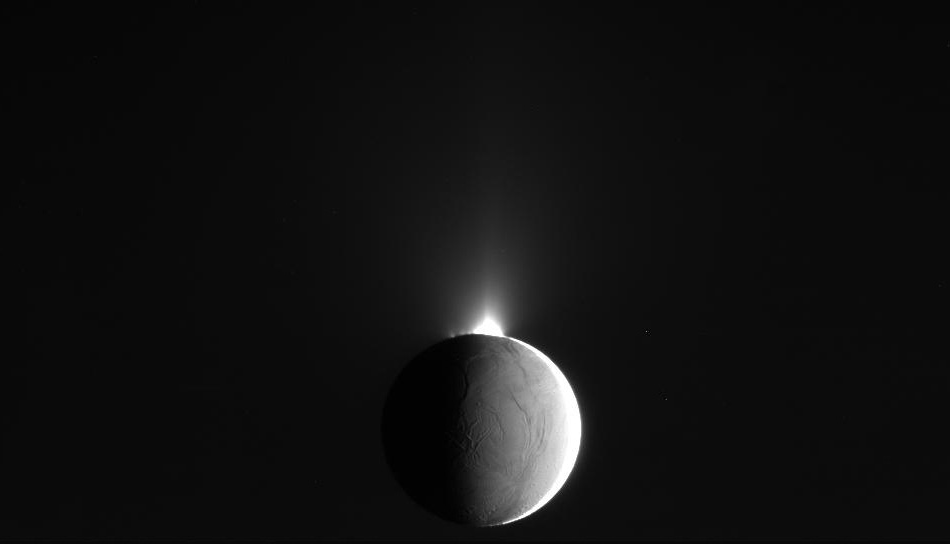
image by NASA (source)
~~~~~~~
And staying in the theme of following up on stuff I've written a bit about before, you may recall that back at the end of May I wrote about an unusually large, unusually powerful gamma ray burst picked up by the Swift satellite:
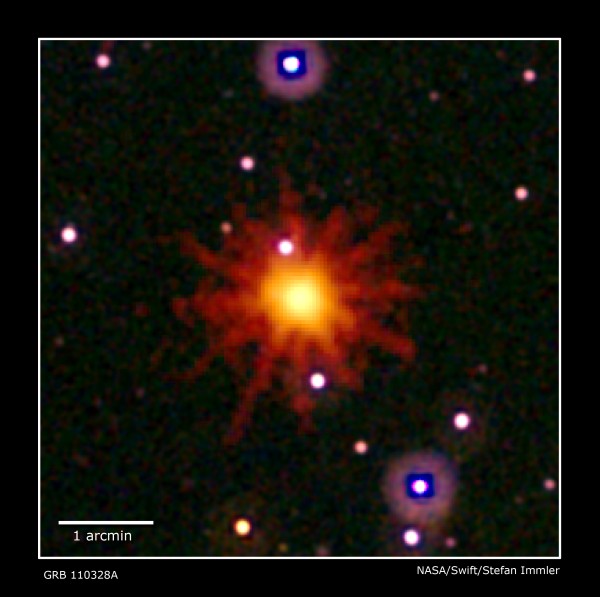
image by NASA (source)
The thinking at the time was that all that energy probably resulted from a star being pulled into a large black hole, and according to this recent article, that has now been confirmed, and the source galaxy identified as "a small galaxy in the Draco constellation, some 3.8 billion light-years away." So that galaxy's central supermassive black hole sucked in a star; gravitational, electromagnetic, and who knows what other forces tore it apart as it fell into the hole; and the hole's magnetic field channeled much of the resulting energy into beams shooting out from the poles of the supermassive black hole--and we just happened to be in the way of one of them, 3.8 billion years later.
~~~~~~~
And then there was the announcement last week that Iran had launched its second satellite, "Rasad," meaning "observation," into orbit, supposedly to take photos for high-resolution maps of Earth. Their first satellite launch, "Omid," took place in 2009; and last year, they claimed to have "launched a rocket carrying a mouse, turtle, and worms into space."
Good on them, I suppose (less good for the mouse, turtle, and worms; of course you'd think if they do have a good camera up in space they'll have lots of things they'll be using it to peer into in oh say the United States, but hey we do the same to them--and to animals with one-way tickets to space), although when the announcement comes via their state TV, beginning with a phrase like "our glorious scientists," and with no external source being able to confirm such launches, you kind of wonder a bit. But here's hoping they are coming closer to space exploration, and to the international scientific cooperation that almost inevitably goes along with it.
|
·····
|
| |
| An actually pretty decent A* video | Jun 18, 2011 5:22 AM PDT | url |
| | |
Added 1 new A* page:"A* has some of the only consistently intelligent use of negative space that I've seen in webcomics."
-- Nick Wirtz, The Radiant Ones |
Having said yesterday that M87 was the galaxy boasting the largest supermassive black hole (6.6 billion Suns worth of mass) that we're fairly confident of knowing with some accuracy, I went looking after that for what the very largest known is supposed to be, and that search came up with the supermassive black hole at the center of galaxy OJ 287, at the significant distance of 3.5 billion light years from Earth (M87 is a relatively nearby 53 million light years distant). OJ 287's central black hole has been calculated at 18 billion solar masses; and as if just to emphasize how ridiculously massive that is, fluctuations in its signal have been interpreted to be caused by ANOTHER supermassive black hole orbiting it so closely that it is punching through OJ 287's accretion disk as it goes around and around; that little half of this supposed supermassive binary is a *mere* 100 million solar masses (that's 25 times the size of Sagittarius A*, the supermassive black hole at the center of our own Milky Way galaxy), and it is projected to be swallowed by the 18 billion solar masses black hole in the brief time span of just 10,000 years.
The accuracy of this data has been called into question, though, so who knows. But it does make for an interesting mental image to ponder! And if you'd like it dramatically animated for you, it's covered in this video, which, while going a little too heavy on the CG animation, haunting music, dramatic reading, and zooming and rotating in on still photos you could just find by themselves on the Internet--these things indeed seem to be be almost inescapable in astrophysics videos aimed at the general public--is actually rather good, and has some quite interesting simulations, visualizations, and descriptions of the formation of supermassive black holes in the early universe:
video on Youtube
And looking through that series, I found they also have a whole episode about A*! And it even has some info I didn't know about before, such as K. G. Jansky's discovery, published to some fanfare in the New York Times in 1933, of a radio source coming from the center of the galaxy, in the direction of the constellation Sagittarius. Jansky discovered the source with his own large antenna, which in effect became the first radio telescope--and this was all done as part of his work for Bell Labs, who wanted to find the sources of static that could interfere with that fascinating new technology, radio broadcasting!
So that was how A* was first detected, although they didn't know what it was at the time. Another thing from the video that I don't think I knew, although it sounds slightly familiar somehow, is a calculation that there are 20,000 black holes within the central three light years of our galaxy; although, given that we have a very difficult time identifying non-supermassive black holes with any degree of certainty, much less those tens of thousands of light years away, and obscured by a lot of gas and dust, I'd sure like to know how someone arrived at that figure.
Anyhow it's probably the best popular science video on A* I've seen. Here it is:
video on Youtube
|
·····
|
| |
| 10,000 times more supermassive black holes | Jun 17, 2011 6:02 AM PDT | url |
| | |
Added 1 new A* page:"A* is exactly what a hybrid of noir and space opera should look like."
-- Jon Del Arroz, Flying Sparks |
You know, I tried--*tried*--to resist drawing Selenis in a black suit--all my storyboards for this episode have her in white--but earlier this week I realized that the drawings of her in her white suit that have been most successful have been the ones where I was using what I guess you could generously call tricks of lighting to make the suit effectively black, for instance in page 39 and page 44. And I'm sure this has nothing at all to do with the years I spent in my previous job, writing and role-playing a female Agent in a dark suit (among other characters) in "The Matrix Online." *cough* Anyway I think black is just her color and that's all there is to it. :P It was time for a costume change, anyway.
~~~~~
Getting back to the discussion of supermassive black holes in the earlier universe from yesterday, a recent analysis of Chandra readings of even older X-rays--these being X-rays emitted just 800 million years after the Big Bang--has concluded that there were many more supermassive black holes, in the X-ray-visible-form of active galactic nuclei, than had previously been thought in the early billions of years of our universe's history: at least 30 million supermassive black holes at that time, which is 10,000 times more than had been previously thought.
Here's the "Chandra Deep Field South" image that helped illustrate that impressive conclusion; it combines Chandra's X-ray view (blue) of those early galaxies with optical (green and blue) and infrared (red and green) views from Hubble:
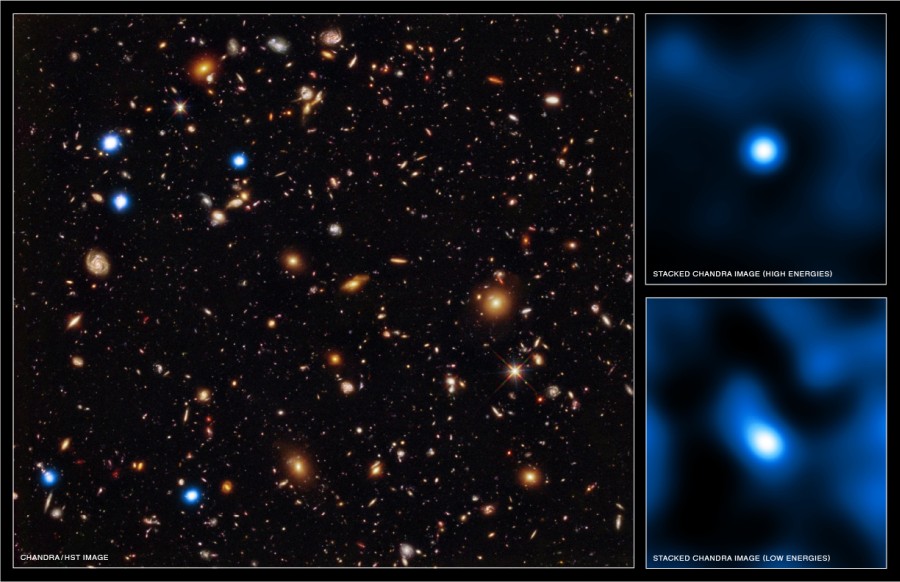
image by NASA (source)
It's actually a bit of a confusing illustration, as the 12-billion-year-old galaxies Chandra was examining are faint reddish dots you can barely see in that image, except for the ones with active supermassive black holes giving off X-rays, which are in Chandra's bright blue. I think. They think that they weren't able to see the active nuclei at the centers of so many of those galaxies in visible or infrared light because they were obscured in gas and dust, but X-rays cut right through that stuff, so Chandra's X-ray vision could find many more of these ancient supermassive black holes than other instruments had in the past.
So yet again, more supermassive black holes than anyone had thought existed! And somehow I bet these aren't the last breakthroughs that will find significantly more supermassive black holes around the universe than we'd thought--heck, these are the easy, bright ones they're finding, anyway. What I really want to know is, how many *quiet* ones are there, just lurking out all alone in intergalactic space, each one hiding the mass of millions or billions of stars?
Remember that the largest supermassive black hole known to a reasonable degree of certitude (I think) is the one in M87, a black hole of an estimated 6.6 billion solar masses; I posted a bunch about M87 on the forum here a while back, including photos showing its famous 5000-light-year-long jet, shooting out of that super-duper-massive black hole. Here's a Chandra image of it that I didn't post before, though: it shows the hot, X-ray emitting gas in the cluster of galaxies around M87, in blue, being blown away by energetic particles (in red, detected by radio telescopes) emitting from the intense reactions around the 6.6 billion solar mass black hole at M87's center:
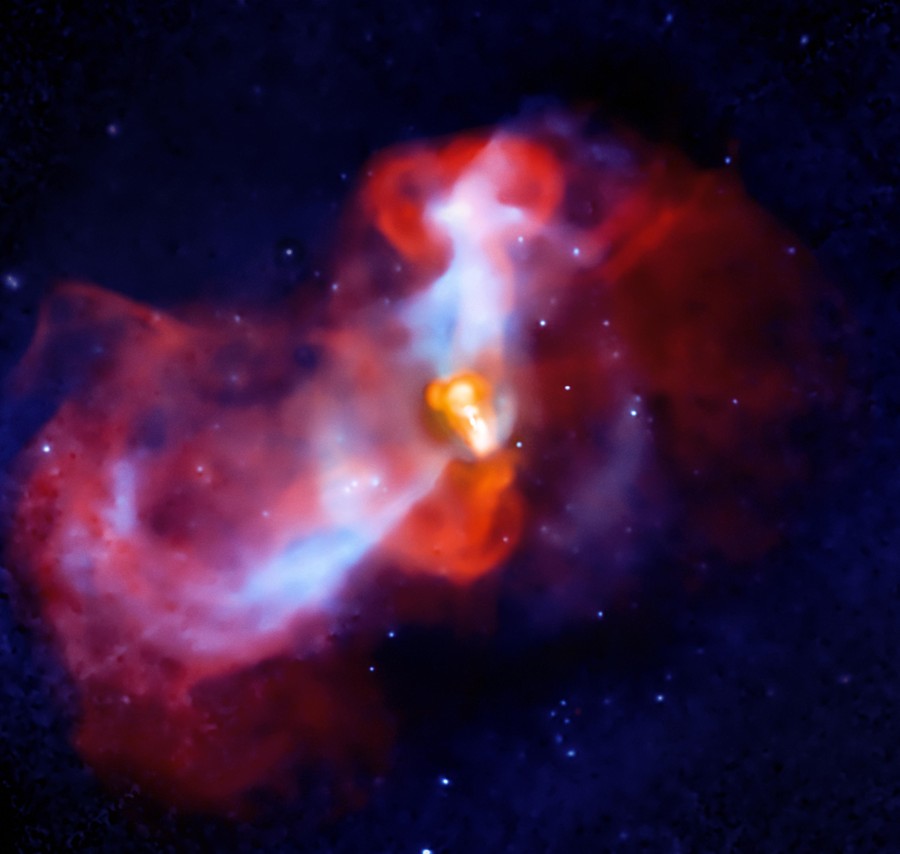
image by: X-ray: NASA/CXC/KIPAC/N. Werner et al Radio: NSF/NRAO/AUI/W. Cotton (source)
So giant black holes like that are pretty easy to find--hard to miss, really--but there must be plenty with no gas around them: nothing to react with, and thus emitting negligible energy--almost totally invisible! Gravitational lensing has been used to try to find quiet black holes, and even much smaller things like planets, but I don't think it's been used to search for silent intergalactic black holes on a really large scale yet.
|
·····
|
| |
| Two supermassive black holes better than one? | Jun 16, 2011 5:51 AM PDT | url |
| | |
Added 1 new A* page:"I typically avoid science fiction, but the art's disarmingly unique, the writing too sharp. If even light can't escape the pull of A*, what a fool I was to believe that I could."
-- Anonymous |
An alert reader on Facebook pointed out a new Swift/Chandra discovery of a relatively nearby galaxy with two supermassive black holes merging at the center, the result of two galaxies colliding.
It's been known for a while that the galaxy Markarian 739, or NGC 3758, which is about 425 million light years away, had two galactic cores, one of which was an active galactic nucleus, where a supermassive black hole was actively swallowing vast amounts of material. But it wasn't until Chandra's X-ray vision took a good hard look at it that scientists realized that the second core was also active--a second feeding supermassive black hole in one galaxy!
Here they are in visible light:
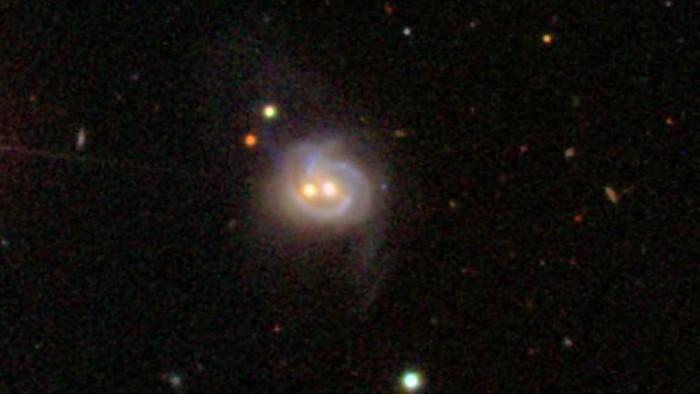
image by NASA/SDSS (source)
The two supermassive black holes--the bright spots at the center of above image--are about 11,000 light years apart.
Indeed, this type of thing doesn't seem to be all that rare; the Burst Alert Telescope (BAT) on Swift has been mapping X-ray sources, detecting active galactic nuclei ("AGN") within 650 million light years, and a study published last year showed that about a quarter of the AGN it has found were either interacting or paired off, with about 60% of them predicted to merge within the next billion years.
There's a mention that deep space X-ray studies indicate galaxy mergers--the source of active galactic nuclei, which are themselves the primary source of deep space X-rays--were much more common in the early universe, and probably peaked around 7 billion years ago. Swift has been finding so many AGN that they may be able to account for the cosmic X-ray background seen throughout the visible universe.
Markarian 739 is the *second* twin active supermassive black hole galaxy found, and the second closest; the record for those goes to NGC 6240, about 400 million light years away. Here it is in visible light as seen by Hubble:
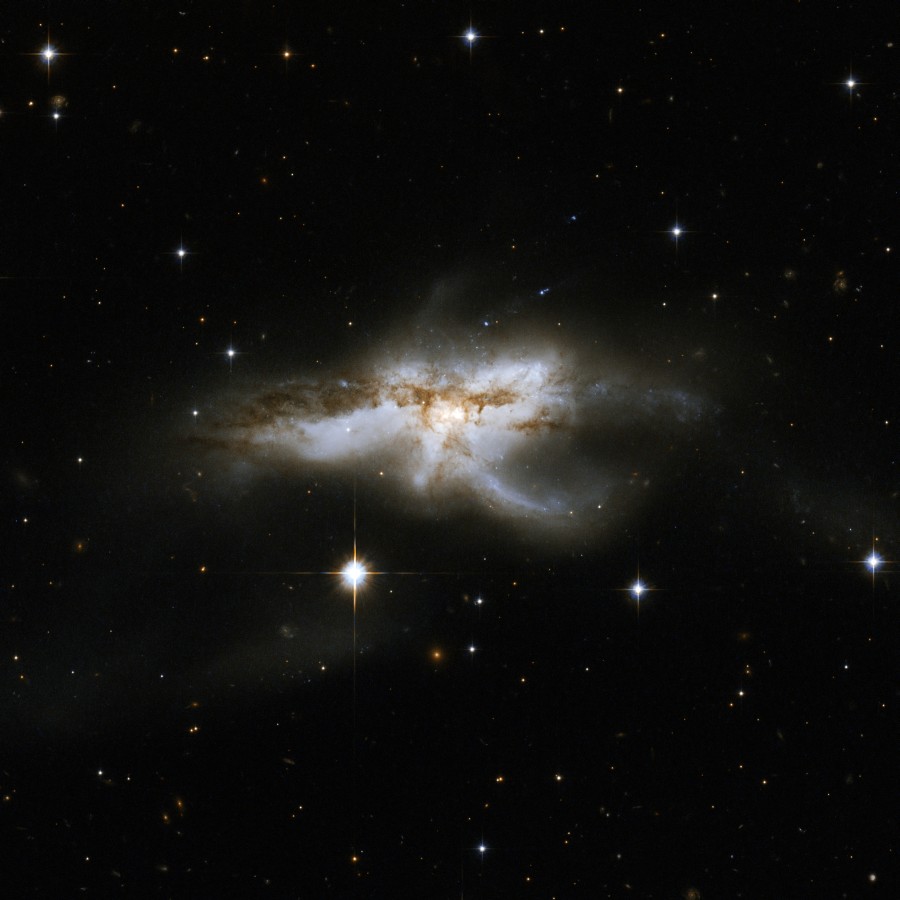
image by NASA (source)
and in X-rays by Chandra (superimposed on a visible light image in yellow), where the two active supermassive black holes at the center are revealed:
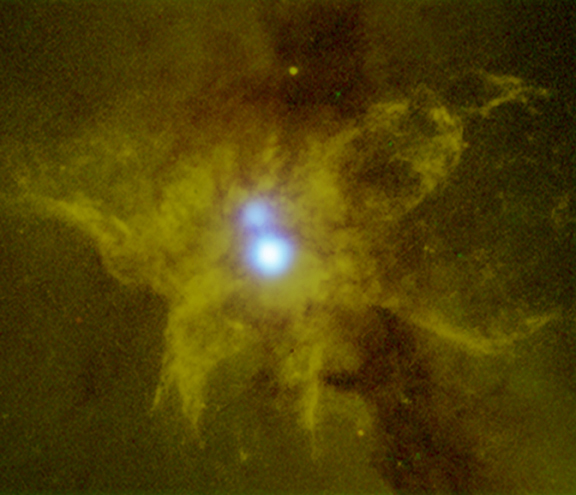
image by NASA (source)
Oh! And I just realized I posted a composite of those two on the forum over a year ago (the nice thing about having a bad memory is that everything old is new again!):

image by NASA (source)
It doesn't do to underestimate the number of black holes out there!
|
·····
|
| |
| The new VST 'scope vs Hubble! | Jun 15, 2011 3:59 AM PDT | url |
| | |
Added 1 new A* page:"When I read A*, I feel like I'm inside the hole itself. The art complements the setting, especially since black and white switch roles as light and shadow. Although the story progresses panel by panel, I am strangely attracted to the universe of A*."
— bunny pandemic, Bunny Pandemic |
This Space.com article informed me that there's a new telescope on the scene: ESO's VLT Survey Telescope ("VST"), in the high Chilean desert right next to the VLT ("Very Large Telescope") that I mentioned and showed a picture of just recently.
The VST's light-gathering mirror isn't all that big by big telescope standards—just 2.65 meters across, vs for instance the four 8.2 meter mirrors of the VLT (or the 100 meter mirror of the ESO's proposed Overwhelmingly Large Telescope, which was however cancelled in favor of the less overwhelmingly expensive 42 meter European Extremely Large Telescope, scheduled for completion in 2018 (no, I am not making these names up! :P)), but it has a wide aperture and a powerful camera (the "OmegaCAM," dun-dun-dunnnn), perfect for sweeping the sky and taking large-scale photographic surveys of space—and of the galactic band of the Milky Way in particular, including A*. :)
So that's neat. Here's an informative video about the VST, with pleasant background music:
[Removed the embedded Flash video; was a space.com source but now just redirects to their YouTube channel. : Pp]
But enough talk, let's see what it can do!
To show it off, the ESO released two pictures, each of an object so large in the sky that it can't be captured in a single image by other large telescopes, such as Hubble, even though Hubble's view is far sharper. Let's compare!
Here's the VST's view of the Omega Nebula, aka the "Swan Nebula," or Messier 17 ("M17"), a cloud of hot, star-forming gas somewhere between 5,000 and 6,000 light years from Earth (isn't it interesting that they haven't really been able to nail down its precise distance yet?), in the direction of the galactic core. The nebula is 15 light years across, an estimated 800 solar masses, and sits in a cloud of material that's about 40 light years in diameter.
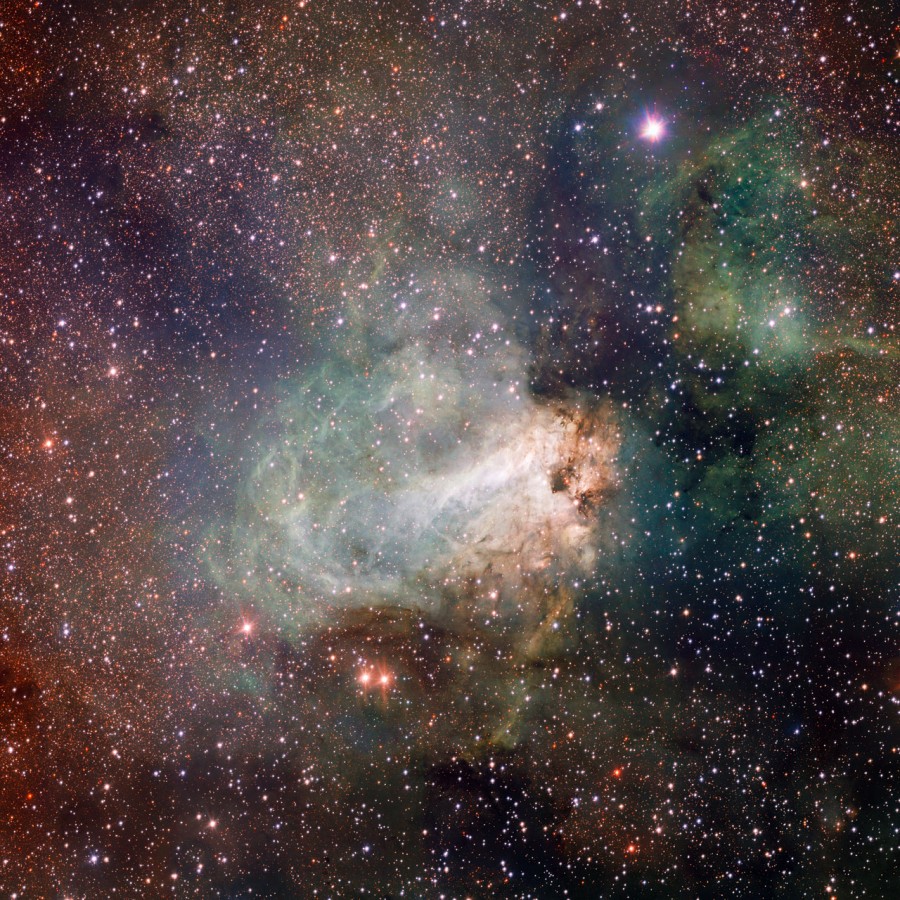
image by ESO/INAF-VST/OmegaCAM (source)
And here's Hubble's view of the same nebula:
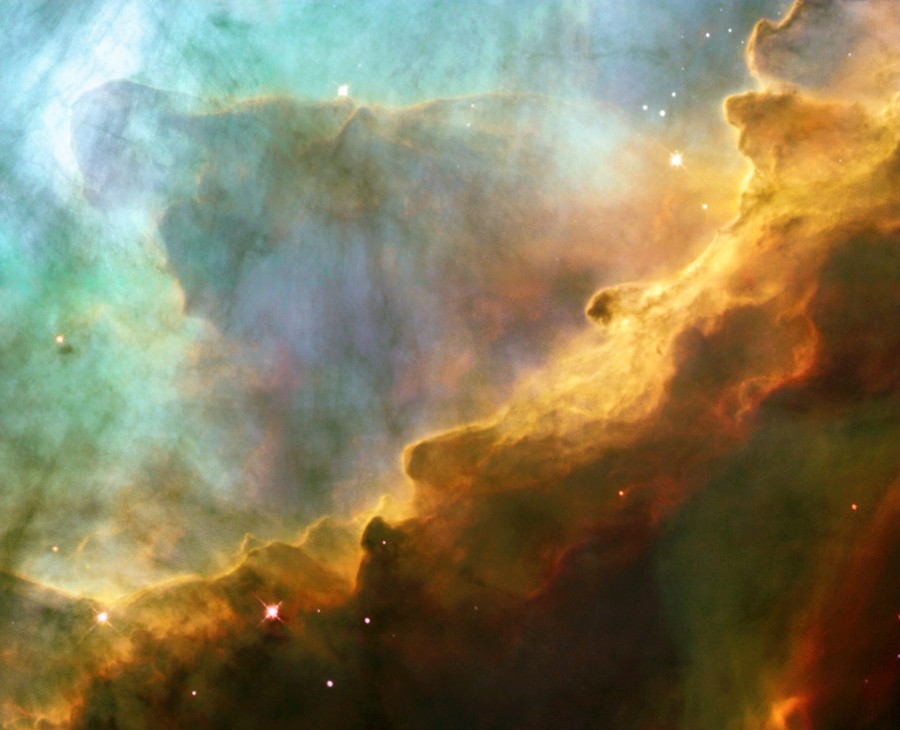
image by NASA (source)
So, the VST is good for seeing it all in one go! The second released VST image is of the globular cluster Omega Centauri, the largest and brightest star cluster in the Milky Way, and the second largest star cluster in our local group of galaxies; it was so bright that Ptolemy was able to spot it, over 2000 years ago—he thought it was a star. Omega Centauri, 15,800 light years from Earth, is about 12 billion years old, and contains several million stars (5 million solar masses), the ones in the center averaging less than 0.1 light years apart.
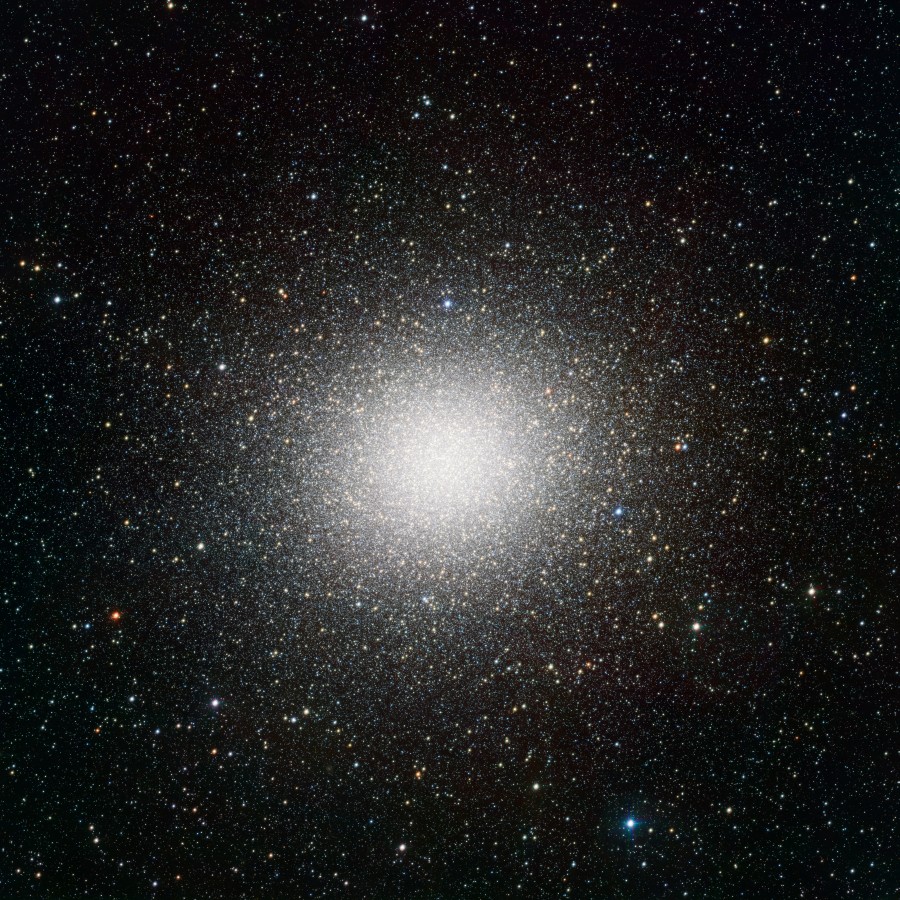
image by ESO/INAF-VST/OmegaCAM (source)
And Hubble's view:
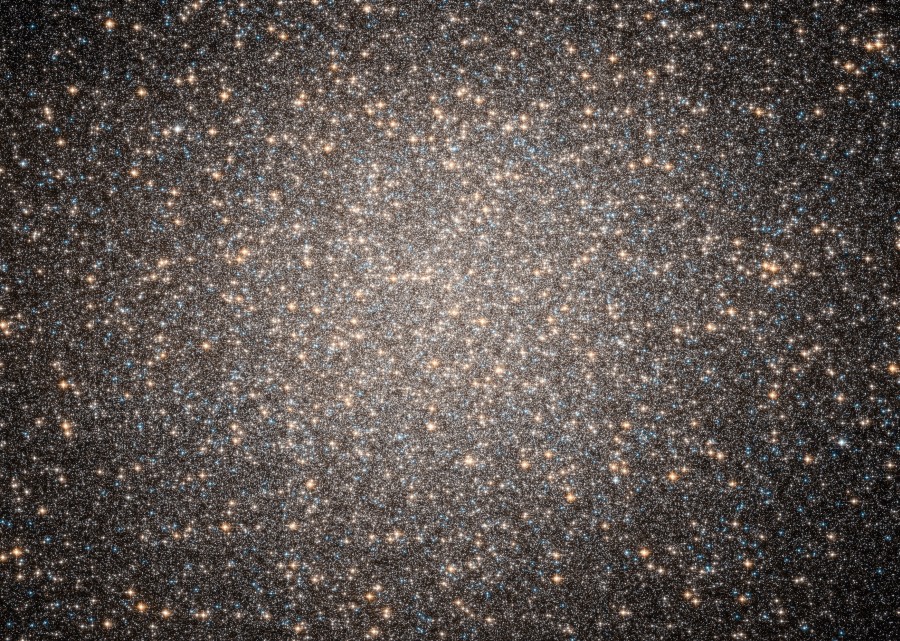
image by NASA (source)
~~~~~~~~
Interestingly, when I first posted about Omega Centauri over here on the A* forum (warning: high bandwidth, although there's a maybe even better photo of the cluster there, taken by telescope at a different ESO observatory in Chile), it was thought that there might be an intermediate-mass black hole of about 4000 solar masses at the center—this was based on readings that seemed to indicate the stars at the center of the cluster were moving faster than those farther out. Subsequent observation, however, has found that star density and speed do not vary significantly at the center, and if there is a black hole there, it must be a much smaller one, maybe no more than 1,200 solar masses. NASA and the ESA even put together a graphic showing the calculated star movements at the core of the cluster; the photo is from October 2010 with Hubble's new Wide Field Camera 3, and the motions were calculated by comparing the positions of the same stars as seen in Hubble photos of the cluster from 2002 and 2006; each streak shows the star's predicted motion over the next 600 years, composed of dots 30 years apart:
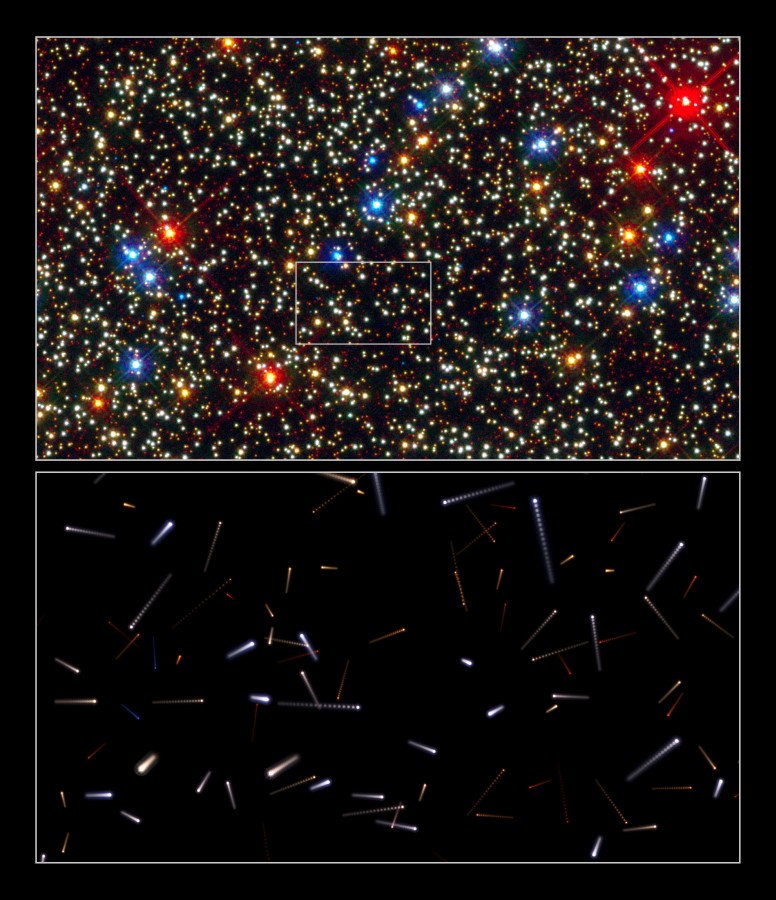
image by NASA, ESA, J. Anderson and R. van der Marel (STScI) (source)
So as you can see, it seems that the stars are moving in random directions, rather than in tight orbits around a central mass; contrast that with the observed motions of stars at the center of our galaxy, around A*, where the stars at the very center are packed as close as light-days apart, and are moving very quickly in tight orbits around a central object: the theorized supermassive black hole A*!
(The ESO, or European Southern Observatory—the organization of fourteen European nations, and Brazil, that runs these vast observatories in Chile and other southern hemisphere locations—should not be confused with the ESA, or European Space Agency, comprised of many of the same nations, but focused on spaceflight rather than ground-based telescopic observation. I'm mentioning this only because I had them a little confused in my head. :P)
|
·····
|
| |
| Sharks with laser beams? | Jun 14, 2011 1:15 AM PDT | url |
| | |
Added 1 new A* page:
"I like the format of Super Massive Blackhole because I can flip through the comic easily. The one-panel per page format and the dialogue on the bottom gives the entire comic a cinematic feel. The sci-fi elements are futuristic, but the look is black and white and classic."
-- Tony DiGerolamo, The Webcomic Factory |
I've asked my webcomic author peers to say something nice about A*, in return for which I'll link to their own comic when I post the quote, so that's what's going on up there. Response so far has actually been quite good, so this could go on for a while. Hopefully this little indulgence of mine won't be too annoying, but you just might find a link to a nifty webcomic you hadn't seen before!
And just to prove this won't distract me from my usual tumultuous forays into science news and beyond, here's a bunch of stuff!
~~~~~~~
I came across a NewScientist.com article highlighting a black hole simulation program that shows how the hole's gravity would bend light around itself, distorting the view of distant stars.
You can even download the program, written by two fellows from the University of Stuttgart. I couldn't seem to get its OpenGL renderer to work on my computer, drat the luck.
~~~~~~~
Innovation News Daily ran an article recently about the Navy's test of their "Maritime Laser Demonstrator," a ship-mounted prototype of a laser weapon. It isn't all that powerful, but in the tests they've been able to use it to burn through outboard motors after a second or two, as is supposedly shown in this video:
video on Youtube
~~~~~~~
It isn't just the Navy shooting lasers these days, though--even green fluorescent protein ("GFP") is getting into the act, according to this LiveScience.com article: scientists working at Massachusetts General Hospital, it says, using genetically engineered kidney cells containing the protein (which normally occurs in some fluorescent sea creatures) and a pair of tiny mirrors to generate a laser from the green light the protein emits.
They came up with the idea because GFP emits its light along very specific wavelengths, which is exactly what you need a laser to do! So they were able to use the tiny mirrors to gather the light emitted by the protein, and focus it into a beam, albeit a pretty weak one.
Neat! Now they've just got to move that from kidneys to something a little more accessible, like say fingertips or eyeballs, and we'll be in business! Or at least, we'll have some cool natural super-hero special effects. :P And maybe the Navy could harness herds of fluorescent jellyfish to take out pirate speedboats!
|
·····
|
| |
| A cool flare | Jun 11, 2011 7:13 AM PDT | url |
| | |
Added 1 new A* page:Heyyyy it's that time of week where I say hey, go check out my weekend fairy tale comic "The Princess and the Giant," and there will even be a new page on Sunday! Although it might be in the evening rather than my usual early afternoon time this time since different people are wanting to hang out at different times than my usual Sunday hangouts, I think. Oh social life, so complicated. However, a new Princess comic will certainly still occur at some point two days (I'm pretending it's still Friday since this is "Friday's" A* page, you see :P) hence, and just so you're up to date, get a load of last Sunday's page by clicking this preview banner:

~~~~~~
And it doesn't hurt to end the weekly A* news column with a visual splash, so how about this:
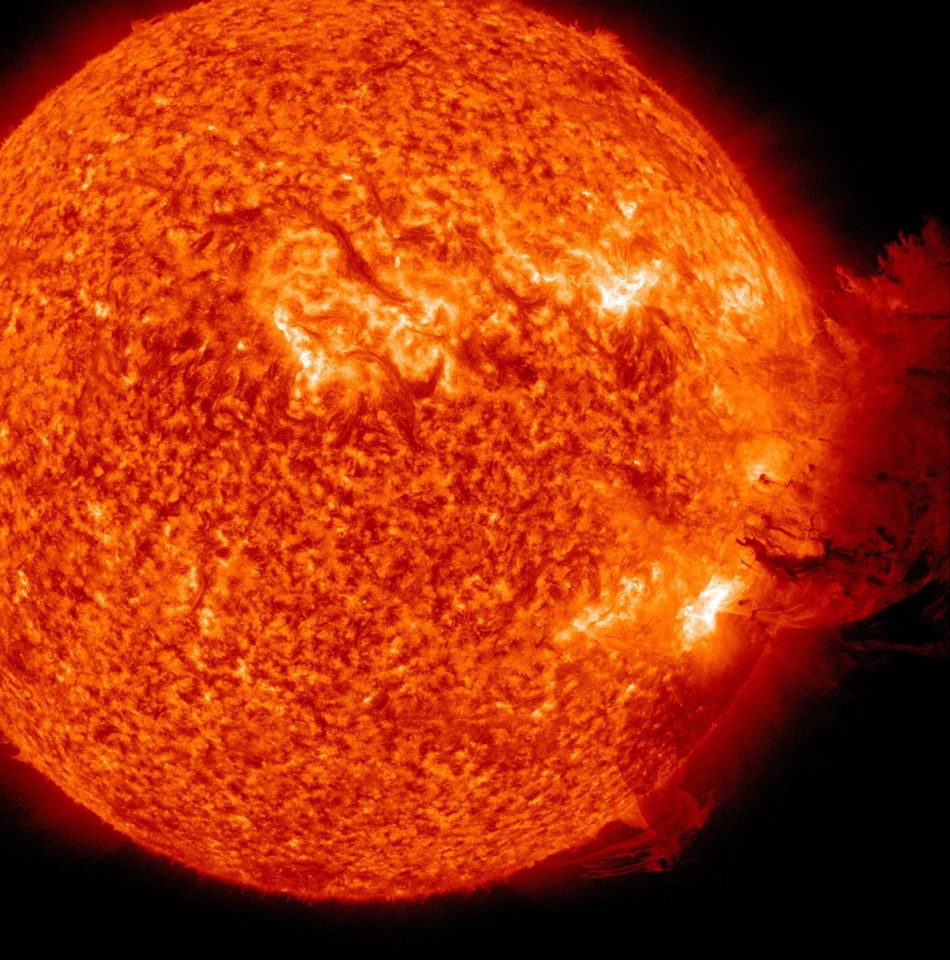
image by NASA (source)
That's a coronal mass ejection ("CME") captured by NASA's Solary Dynamics Observatory ("SDO") a few days ago; it was associated with an M2-class solar flare, which is just a medium-sized one (about 1/10th as powerful as the X2 flare in February, which was the largest in four years), but the CME was a remarkably splashy one, appearing to cover about half the solar surface as it fell back into the Sun. Also, scientists were surprised to find that some of the stuff ejected in the event was, by the standards of the Sun's corona, which runs temperatures in the millions of degrees, very cool--a mere 80,000 K, for instance.
So they aren't quite sure how that happened; CME's are thought to be powered by fluxes in the magnetic field lines of the Sun's corona, and gas that cool isn't usually found there (the Sun's surface, by contrast, can be a cool sub-6000 K).
Stereo A and Stereo B are NASA's two STEREO spacecraft, launched in 2006; they were sent along slightly different slingshot paths around the Moon, which brought them back to different spots in Earth's orbit around the Sun: one in front, and one behind. Since then, they've drifted farther apart along our orbit, and just this February they reached opposite sides of the Sun, so together they can now give us a complete view of the entire Sun!
And early on they made their famous wiggly sun image, which I see I posted the large version of on the forum last year, but here's a smaller version that won't stress the front page too much more than I already am...
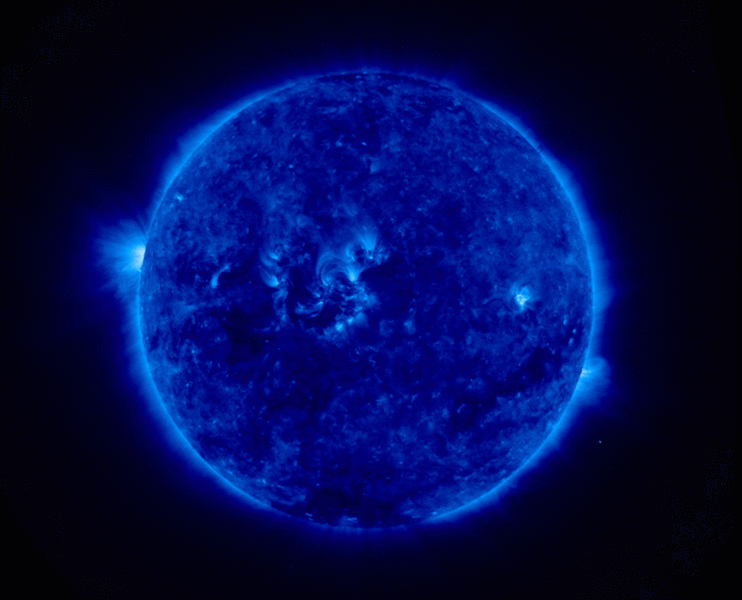
image by NASA (source)
Keen. Also keen is the Solar Superstorm, a four (?) day period in 1859 of intense solar flare activity--so intense it's estimated (from examining nitrate layers in deep soil cores) to happen just once every 500 years. The largest of the flares, the "Carrington Super Flare" after the guy who observed it, is thought to have been the largest solar flare in recorded history. The intense solar activity was accompanied by the largest recorded geomagnetic storm, with very bright aurorae seen around the world--even in the Caribbean!--and telegraph failures throughout Europe and North America, with telegraph feedback shocking some operators, and even starting fires. Let's hope we've really got another oh 350 years before the Sun pulls another stunt like that!
|
·····
|
| |
| Do not try this at...oops. | Jun 10, 2011 4:27 AM PDT | url |
| | |
Added 1 new A* page:Ooh so late/early. One of those days where I tried to resist the pose called for in my storyboard sketch, to no avail. Here I was in the middle of sort of two tries, for instance:

Whaaaaaaa.
|
·····
|
| |
| Shuttle nostalgia hits fever pitch | Jun 09, 2011 2:32 AM PDT | url |
| | |
Added 1 new A* page:I was noticing that now that there are bright images below the comics rather than blank black space, Selenis' (and Mother's) gray subtitles are a little harder to read. So from now on I'm going to do them in white like everyone else's subtitles, and in order for Selenis' subtitles to stand out, I'll just put colons around them like I've already been doing with Mother's computery font text. Of course it's confusing as heck to do this in midstream, particularly in the middle of a chapter, but hopefully it won't be too tough to figure out after stumbling through a page or two in semi confusion. :o
On May 23rd, ESA astronaut Paolo Nespoli was leaving the International Space Station in his Soyuz capsule, and captured some really striking footage of the Space Shuttle Endeavour docked at the station; it's just fascinating to me visually how you can see the sunlight gleaming off the station and shuttle as they rotate relative to the capsule. NASA posted the video here, and there's a gallery of his still photos here; here are a couple of my favorites:
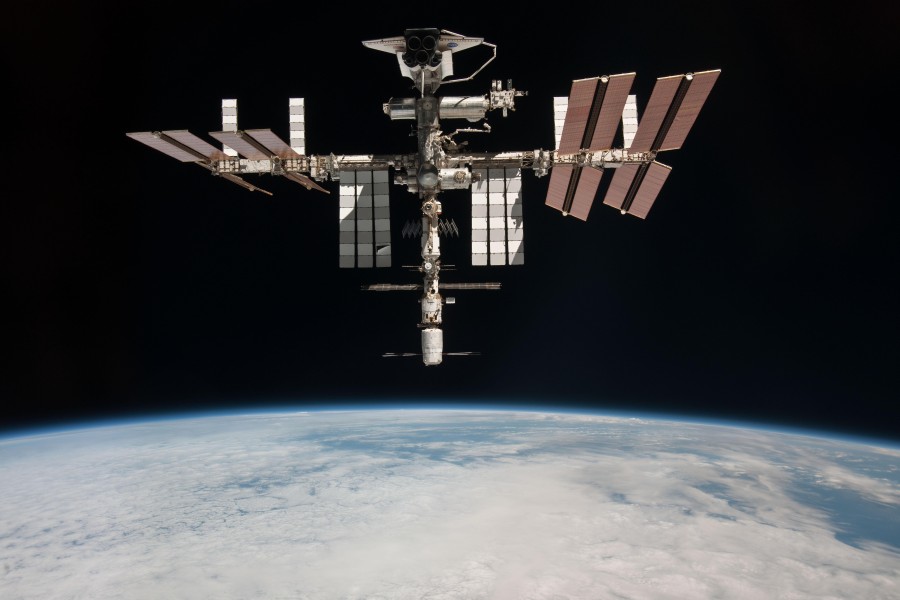
image by NASA/ESA (source)
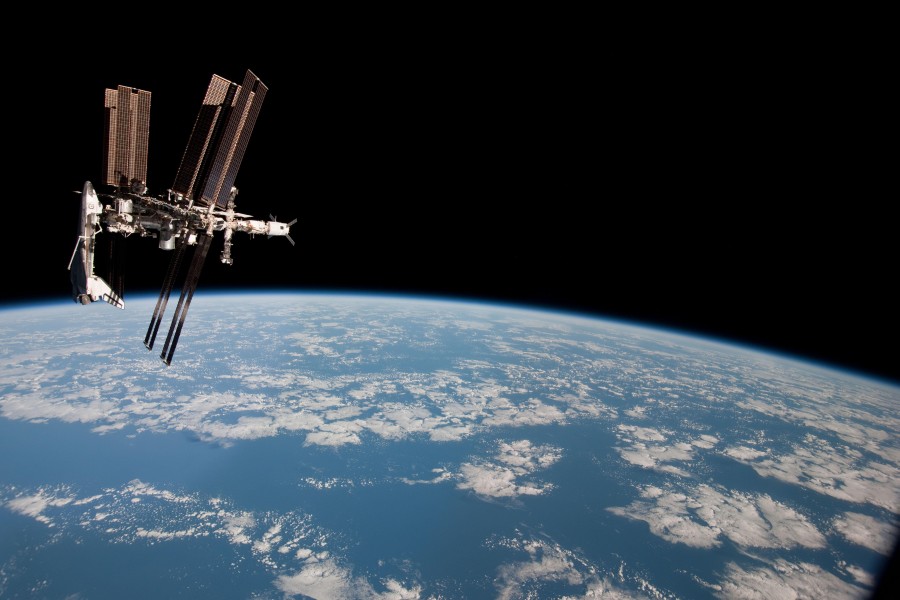
image by NASA/ESA (source)
Nespoli, who is Italian, flew on the Space Shuttle Discovery back in 2007; this Soyuz mission, which launched for the ISS on December 15th of last year, was his second space flight--he had been in training with the ESA and NASA since 1991! And very unfortunately, his mother passed away on May 4th, while he was in space. Here he is playing with that silly robot spaceman, Robonaut 2, on the station in March:
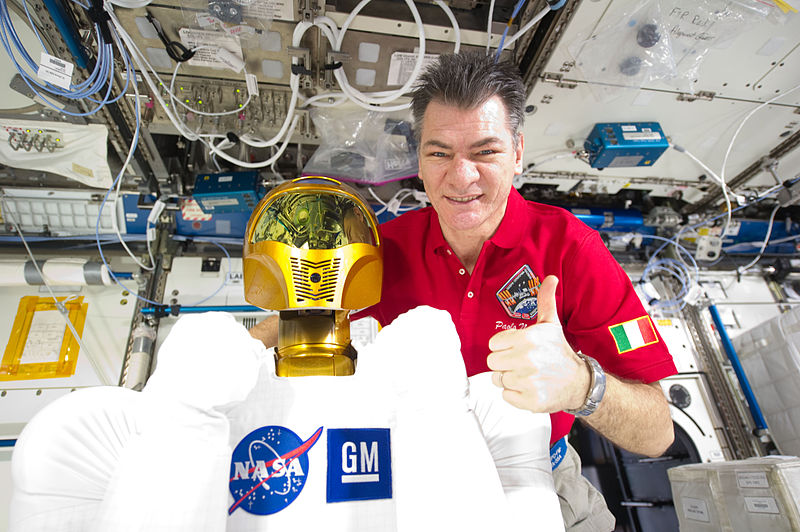
image by NASA (source)
Here's a version of his video with some nice classical music. And here's the latest Soyuz mission taking off from Baikonur Cosmodrome in Kazakhstan earlier today, taking three astronauts--a Russian, American, and Japanese--up to the ISS:

image by NASA/Carla Cioffi (source)
<3 those angled rocket boosters. :D
And really, Shuttle nostalgia must be hitting fever pitch here with just one mission left; today I was *also* linked to this nifty compilation of astronaut footage of Earth from orbit:
video on Youtube
|
·····
|
| |
| Fireball! Fireball! | Jun 08, 2011 3:23 AM PDT | url |
| | |
Added 1 new A* page:On May 20th, NASA cameras captured images of a "man-sized fireball meteor over Macon, GA":
video on Youtube
Kind of neat how you can see it come in and then break up. What really surprised me about this was that NASA even *has* cameras set up to capture such events: turns out that's their All-Sky Fireball Network, which sounds grand but currently consists of four black and white networked cameras pointed upward in Alabama, Georgia, and Tennessee. They're meant to record "fireball" meteors, which means any meteor brighter than Venus in the night sky (huh!). This particular fireball meteor was the brightest they've seen in their three years of observation; when it entered the atmosphere, it was moving at about 24 miles per second (86,000 miles per hour), and 'at this velocity, the boulder-sized "dirty snowball" possessed an energy or striking power somewhere between 500-1000 tons of TNT' (that would be 1/40th to 1/20th the power of the Fat Man nuclear bomb dropped on Nagasaki)--but it broke up in the atmosphere, and didn't do any damage.
|
·····
|
| |
| How not to lock your gimbals | Jun 07, 2011 12:03 AM PDT | url |
| | |
Added 1 new A* page:I saw the movie "Apollo 13" over the weekend! Yeah I know I'm like 15 years late on this. Anyway I quite liked it, although boy did they really make everything REALLY DRAMATIC. :o
If you can remember back through the years to when you saw the movie, in one of the early space scenes they're trying to maneuver or something and everyone starts shouting that the ship is getting close to "gimbal lock." They kept saying "gimbal" over and over in that scene, so I had to go look it up today. Turns out that a gimbal is just a freely rotating ring, like the three you put together, one inside the other, to make a gyroscope:
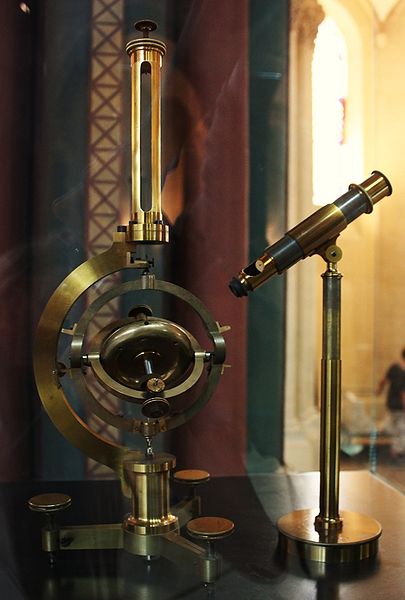
image by Stéphane Magnenat (source)
(^That's an 1867 replica of Foucault's 1852 gyroscope.)
So gimbal lock is when a ring rotates so it's flush with the ring on which it's mounted--at that point, the gyroscope has effectively lost a rotation axis; it isn't physically stuck really, but it can't adjust freely along one of its axes from that position, which can interrupt whatever someone was trying to do with the gyroscope; in the Apollo missions, they were important parts of the system that told the pilots and controllers which way the ship was oriented--so I *guess* if you hit a "gimbal lock" point as you're maneuvering around, the smooth tracking or orientation is lost as the gyroscope has to snap itself around and get back on track.
A brush with gimbal lock had also occurred with the Apollo 11 Command Module, just a few hours after the Lunar Module had landed on the Moon; Command Module pilot Mike Collins had to maneuver out of it (if gimbal lock had occurred, the ship's tracking system would have been disrupted, and Collins would have had to re-orient manually, ie without computer assistance), and then said jokingly to Mission Control "How about sending me a fourth gimbal for Christmas." Mounting a fourth gimbal inside the third gimbal of a gyroscope was the mechanical way to avoid gimbal lock; NASA hadn't wanted to add a fourth gimbal, apparently for cost and development reasons (instead they'd come up with an extensive document of procedures for avoiding gimbal lock), although earlier missions such as Gemini had had a fourth gimbal.
Nowadays of course if you're really high tech you don't have those troublesome gimbal things in your ship at all, but other fancier stuff I understand even less!
~~~~~
I followed a link over the weekend to this old article on self-publishing by "Cerberus" comic author Dave Sim, and I noticed he said "The cliche (which isn't a cliche, it's the truth) is that you have two thousand bad pages in you and until you draw them, you won't start producing good pages." Well I added up the pages of all my comics and what do you know, I'm up to about 1,850 or so. Soon I'll be able to start producing good pages--this is exciting! :D
|
·····
|
| |
| Electrons: still round | Jun 04, 2011 5:54 AM PDT | url |
| | |
Added 1 new A* page:If you think dressing for work can be tricky sometimes, just think how it would be if your workplace had areas with different levels of gravity, like a lot of the space stations in A* do (the effect of gravity being due to the centrifugal force of the rotating sections of the station, of course)--skirts might be risky, and hair spray or something similar might become very important.
Anyway hey it's the weekend! And on Sunday there'll be a new page of my weekend fairy tale comic, "The Princess and the Giant"; here's a handy banner link preview thing you can click to go to last week's page, if you need to catch up:

But hey let's have some science! This recent LiveScience article talks about a project that was just done to measure the shape of the electron, which "found it to be as much a perfect sphere as can be measured, down to less than a millionth of a millionth of a millionth of a billionth of a centimeter."
Now that doesn't really sound surprising to you, probably, since we're all taught in high school or whatever that all those little things like electrons are nice little round balls. They aren't really, of course; in fact to the best of our knowledge they're areas of certain quantum states with virtual particles fizzing in and out, with maybe a one-dimensional "point-like object" at the center. So what they were in fact measuring was the virtual particle cloud around electrons, and they did this by "firing pulses of ytterbium monofluoride molecules between electrified plates," and then using "lasers to measure how the molecules twisted within these electric fields to deduce the shape of their electrons." Fun!
One of the reasons why they think knowing the shape of the electron as precisely as possible is important is because in theory the positive and negative poles of the electron should deform it ever so slightly from the perfect sphere shape, and just how much it differs from a perfect sphere could explain some mysteries in physics, like why matter seems to behave slightly differently than antimatter (supposedly the universe began with half matter and half anti-matter, but they can't figure why the universe now seems to be almost totally matter-dominated), and why our figures for how much matter should be around are so far off from how much matter we can actually find.
It appears though that they weren't all that surprised that they didn't find a deviation from a spherical shape, because "the standard model of particle physics currently predicts that any distortion in an electron's shape is far too small to detect, being some 100 billion times beyond the sensitivity of current experiment." Huh! So I guess they've got a way to go before they can really test that aspect of the standard model.
~~~~
I went looking to see why ytterbium monofluoride in particular might have been used in the experiment, and my extremely lazy search didn't find anything. BUT it reminded me that the discovery of ytterbium, element number 70, is kind of an interesting one: in 1878, a Swiss chemist was digging around in a type of earth then known as "erbia" in a mine near the Swedish town of Ytterby, and he found a new type of stuff in the erbia, which he named "ytterbia" after the town nearby with the weird name. He suspected ytterbia contained a new element, which he speculatively named "ytterbium."
That was hardly the end of it, though! Later scientists found that his ytterbia actually contained a bunch of stuff, which at various periods of investigation was called things like neoytterbia, lutecia, aldebaranium, and cassiopeium. Today, "lutecia/cassiopeium" is known as the element "lutetium," and although the Ytterby mine doesn't get the credit for the discovery of that element for some reason, it *is* credited as the discovery site for a bunch of other elements besides ytterbium: yttrium, terbium, erbium, holmium, thulium, and gadolinium. Seven elements! Quite an important little mine in the history of chemistry. Chemists from the University of Nottingham even made a video of a trip they took there, and here it is:
video on Youtube
Have a nice weekend! Maybe discover some elements or something, who knows!
|
·····
|
| |
| Do Clones Dream of Identical Sheep? | Jun 03, 2011 1:52 AM PDT | url |
| | |
Added 1 new A* page:Here's a quick thing I drew today for an art challenge (over on the ComicFury forums), "draw your character sleeping":

Makes you wish you had your own neutral-buoyancy growth tank to sleep in, doesn't it? Some clones have all the luck. Anyway for future reference, that drawing can be found in the episode 13 gallery; you get to the galleries from the "episodes" link on the site's top menu.
A thoughtful reader on Facebook linked me to a nifty CG video from the American Museum of Natural History that illustrates the relative size of the known universe, kinda:
video on Youtube
There have been videos doing that sort of thing for years, but this one is nice in a number of ways: a) labels distances in terms of the speed of light, b) nice pretty views of the dusty band of the Milky Way (and A* hidden inside it), and c) the positions and sizes of objects are actually based on real data. I'd have liked them to have rendered the local cluster of galaxies as they might actually look, rather than just as green dots, but still, a nice video.
Hm and from incoming traffic I noticed that another thoughtful reader posted a link to the beginning of this episode's job interview scene in the webcomics section of popular networking site Reddit, which led a bunch of new readers here today. Much appreciated, thank you! :)
|
·····
|
| |
| Building an uglier spacecraft | Jun 02, 2011 2:13 AM PDT | url |
| | |
Added 1 new A* page:This NASA article from last week talks about a new technology they're working on for cooling spacecraft (and lots of other things, potentially), called "electrohydrodynamic (EHD)-based thermal control." Instead of using mechanical things like pumps to move coolant near high temperature electronics in order to cool them down, EHD uses electrical fields to move the coolant--no moving parts needed! NASA says the EHD method is more energy-efficient than traditional cooling methods, and can be scaled down easily, to work on really tiny things.
Here's a close-up of a little EHD electrical cooling pump:

image by NASA (source)
That pump is due to go up in a suborbital rocket in June, and that launch is also going to be a demonstration of NASA's SMART satellite platform; SMART ("Small Rocket/Spacecraft Technology") is a 16" diameter "microsatellite," designed to be easy to configure for multiple uses, "and readied for launch in as few as seven days for less than $1 million." This SMART satellite will have EHD cooling, and a SpaceCube computer processor, which NASA says is "25 times faster than the current state-of-the-art microprocessor." Huh! SpaceCube processors have already been on space missions, for instance one was used in an "autonomous docking experiment" during the last Hubble servicing mission in 2009.
I went looking for a photo of one of these little SMART satellites, but couldn't find one. Note that they're not to be confused with SMART-1, ("Small Missions for Advanced Research in Technology") which was a nifty little Swedish/ESA satellite that went to the Moon in 2003 using an efficient Hall effect ion thruster; Hall effect thrusters use electric fields to ionize and accelerate their propellant, producing thrust, like this NASA one using xenon propellant:
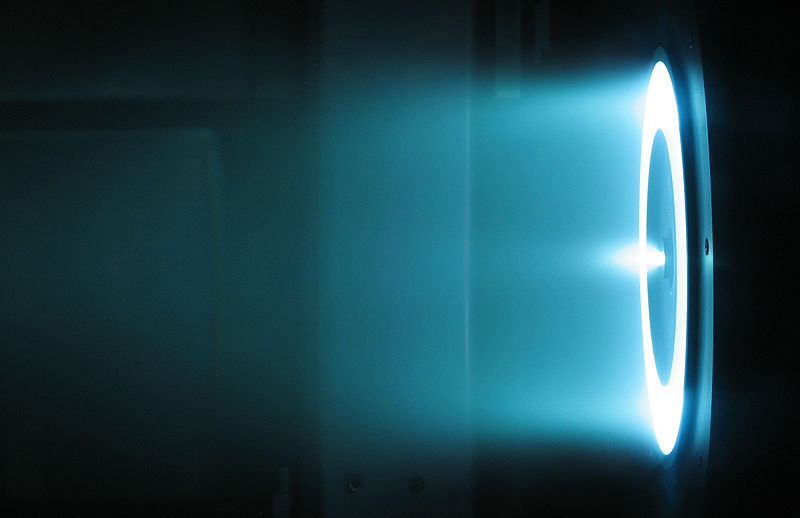
image by NASA (source)
Compared to traditional combustion rockets, ion thrusters aren't very powerful, but they're highly efficient--SMART-1's was three times as efficient as the best chemical rocket, and was powerful enough to get the 1-meter spacecraft from Earth orbit to the Moon, although it took it about sixteen months to do so. At any rate, they look pretty darn cool. And the SMART-1 mission to the Moon only cost about $170 million, which is pretty decent when you consider that NASA estimates that the Apollo program cost about $170 *billion* (in 2005 dollars).
SMART-1 was a sort of ugly cube thing, which you can see on its rocket mounting here.
NASA's SMART is also not to be confused with their CubeSat launch initiative, which has proposed to send a number of university created cubesats into space on launch vehicles already scheduled to go up in 2011 and 2012. According to that last link (to Wikipedia), cubesats are 1-liter (10cm cubes, ~1.33 kg; much smaller than the 367 kg SMART-1, or NASA's 40cm diameter SMART) satellites--this seemed to be a useful, efficient size for tiny satellites that can stow away on pretty much any space launch, I guess, and they appear to be popular with academic and research institutions. Various educational, commercial, and international groups have put cubesats into orbit, but NASA hasn't had much luck with the little things: two of theirs were lost in a SpaceX Falcon 1 launch failure in 2008, and three that they were carrying up for universities perished in the same launch failure that killed their Glory atmospheric research satellite back in March of this year. Hopefully NASA's next brushes with cubesats will be more successful!
They really gotta start coming up with names other than "smart" and "cube" for things, though. Also, sexier spacecraft designs, please. =P These cubes, however smart, are hard to draw science fiction inspiration from!
|
·····
|
| |
| Another view, and why Mars is tiny | Jun 01, 2011 3:07 AM PDT | url |
| | |
Added 1 new A* page:Here's a cleaned-up and then grayed-up full-size version of the storyboard for today's A* page (a tiny, cropped, pre-cleaned version can be seen back in this news post):

I thought I was going to draw today's final art from that same viewing angle, but I noticed that it's a little tough to see what she's looking at from there, and in something of a change from recent pages, I wanted to be relatively unambiguous about the direction of her gaze this time; also, the composition feels a little too cramped vertically, at least when the 75 vertical pixels the subtitle bar covers at the bottom are taken away. But in this rather taller format, I think it's not too bad.
For future reference, this version can be found in the episode 13 gallery (the gallery pages are accessible from the "episodes" page in the site's top menu).
~~~~~~~~
Yesterday was full of talk of Martian meteorites, and it just so happens I recently came across another article featuring them, for a different reason: this BBC article discusses a new study that looked at 44 meteorite pieces from Mars (I *think*--the crucial language is a little scattered), examining their concentrations of thorium, a radioactive element, and hafnium, a very stable element--possibly to compare their ratio, and the less thorium to hafnium there was, the older the rock was, since thorium decays over time? Anyway, the conclusion from however the measurements were used is that Mars took about 2 to 3 million years to form--as opposed to Earth, which "is thought to have taken tens of millions of years to grow to its current size" (note that these time spans cover only the actual accumulation of mass, not the total age of the planet; Earth is thought to be about 4.5 billion years old in total).
This relatively short formation period for Mars could explain why Mars is so tiny; simulations of Solar System formation show that, based on its position as the planet just beyond Earth's orbit, Mars *should* be close to Earth's size, but in fact it's only 1/10th of the size of Earth.
It is thought that when the primary phase of planetary formation ended--circa 3 to 10 million years after the birth of the Solar System, when the Sun's solar wind blew the remaining loose gas and dust they'd formed from away--there were "50–100 Moon- to Mars-sized planetary embryos" winging around the young system, and these proceeded to smoosh together and add the remaining mass to the inner planets. Since we noticed yesterday that the "Earth was hit by a Mars-sized planetary embryo, making the Moon" theory is looking increasingly shaky, we have to be a little skeptical of these two planetary articles I've linked today, since both still hold up that theory as the best one going, but it *is* interesting to see a mention of the theory that one such object hit Mercury, blowing off its outer shell--Wikipedia's Mercury article doesn't mention it at all; it does talk about how its iron core is very large relative to its total size, so maybe that's where the theory comes from.
Anyway, the thinking in this BBC Mars article is that Mars really is one of those old "planetary embryos," and didn't grow to its expected size because it just didn't happen to run into any more of them, so it had no more mass coming in to build it up. The conclusion in the article, quoted from a British astrophysicist, is that this lack of collisions was "just luck," which isn't very satisfying--so why not speculate a bit, since I'm not a scientist? :P I can't help but notice that Mars is situated next to the mammoth Jupiter, which even in our short observation history has been seen to cause disruptions to small bodies from Mars outward; so it isn't hard to imagine that the presence of Jupiter could have diverted all that supposed early embryo planet activity away from Mars.
And because it's always nice to have some sort of illustration with a bunch of words, here's a nice view of Mercury's supposedly embryo-denuded south pole from 10,000 km up, taken just two months ago by the MESSENGER spacecraft, which earlier this year became the first craft to orbit that innermost planet (I have a lot more on MESSENGER, and more pictures of Mercury, in A* posts from earlier this year, here and here, when it was approaching and going into orbit):
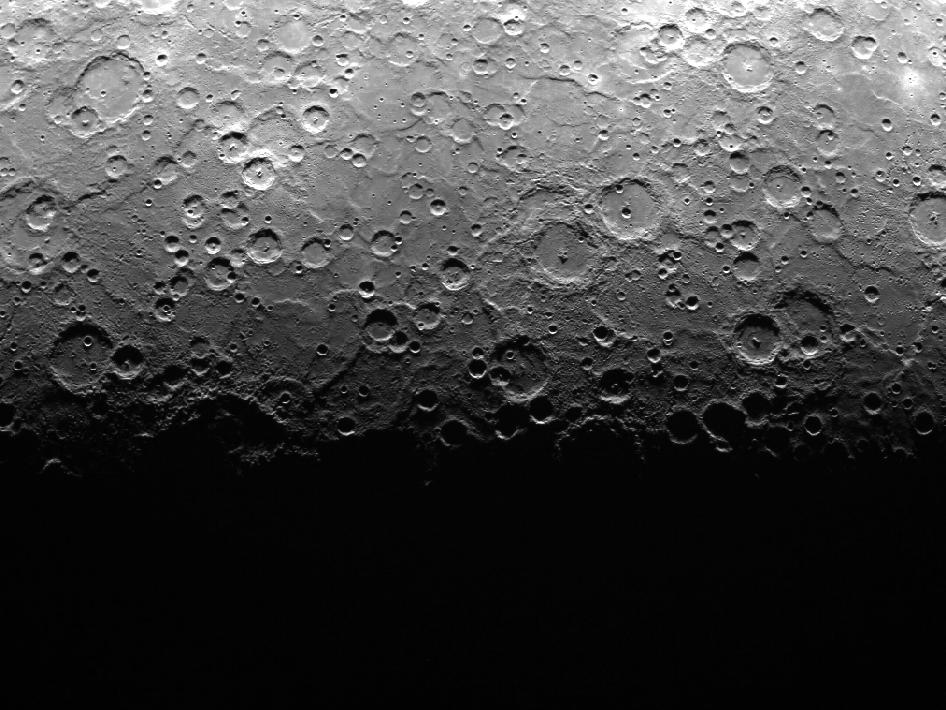
image by NASA (source)
(There aren't too many yet, but MESSENGER is in full operation now and snapping away, so there are more photos from it in NASA's MESSENGER gallery.)
|
·····
|
|
|
